The dirty practices of a Zug-based mining group in Borneo
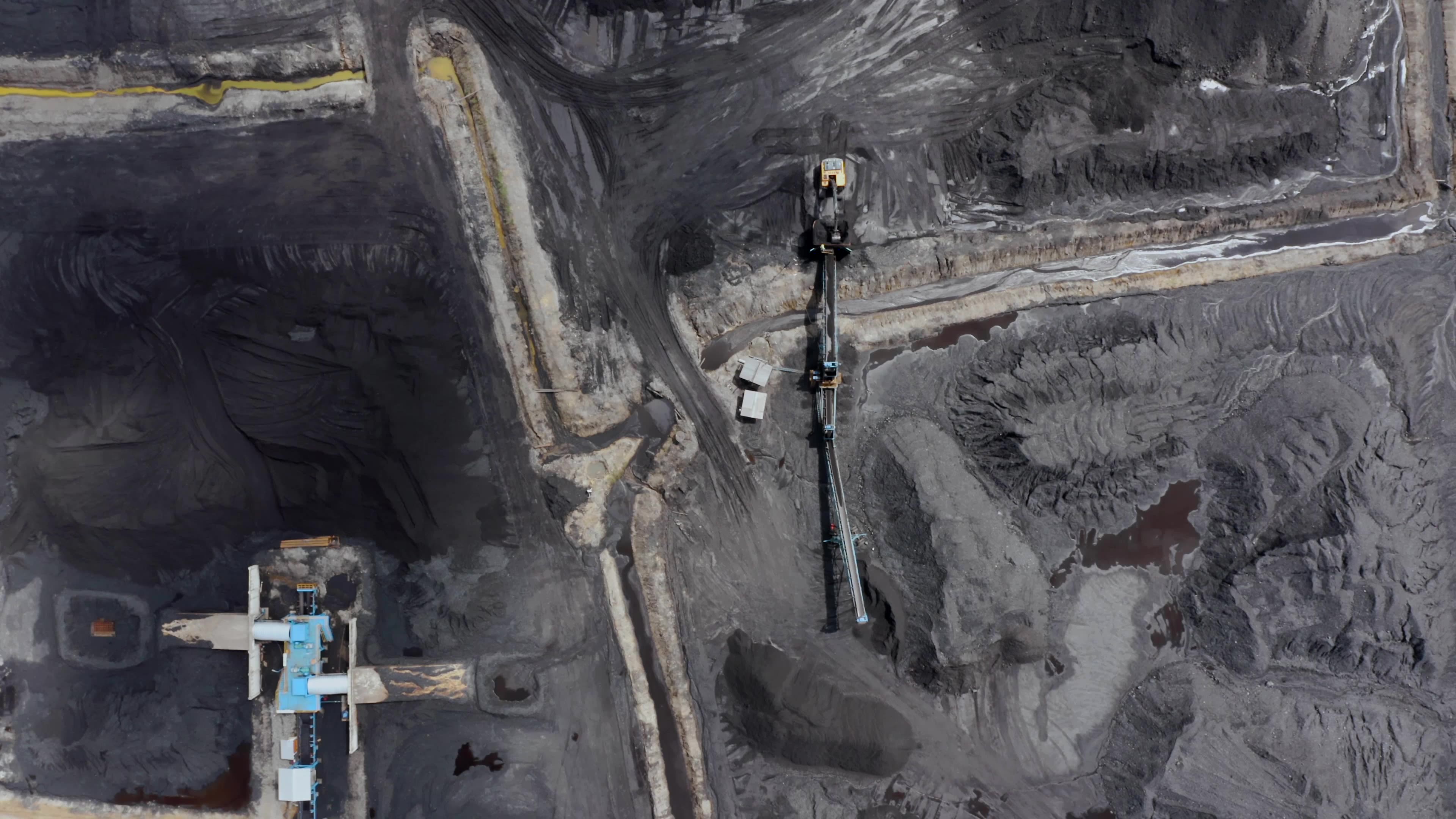
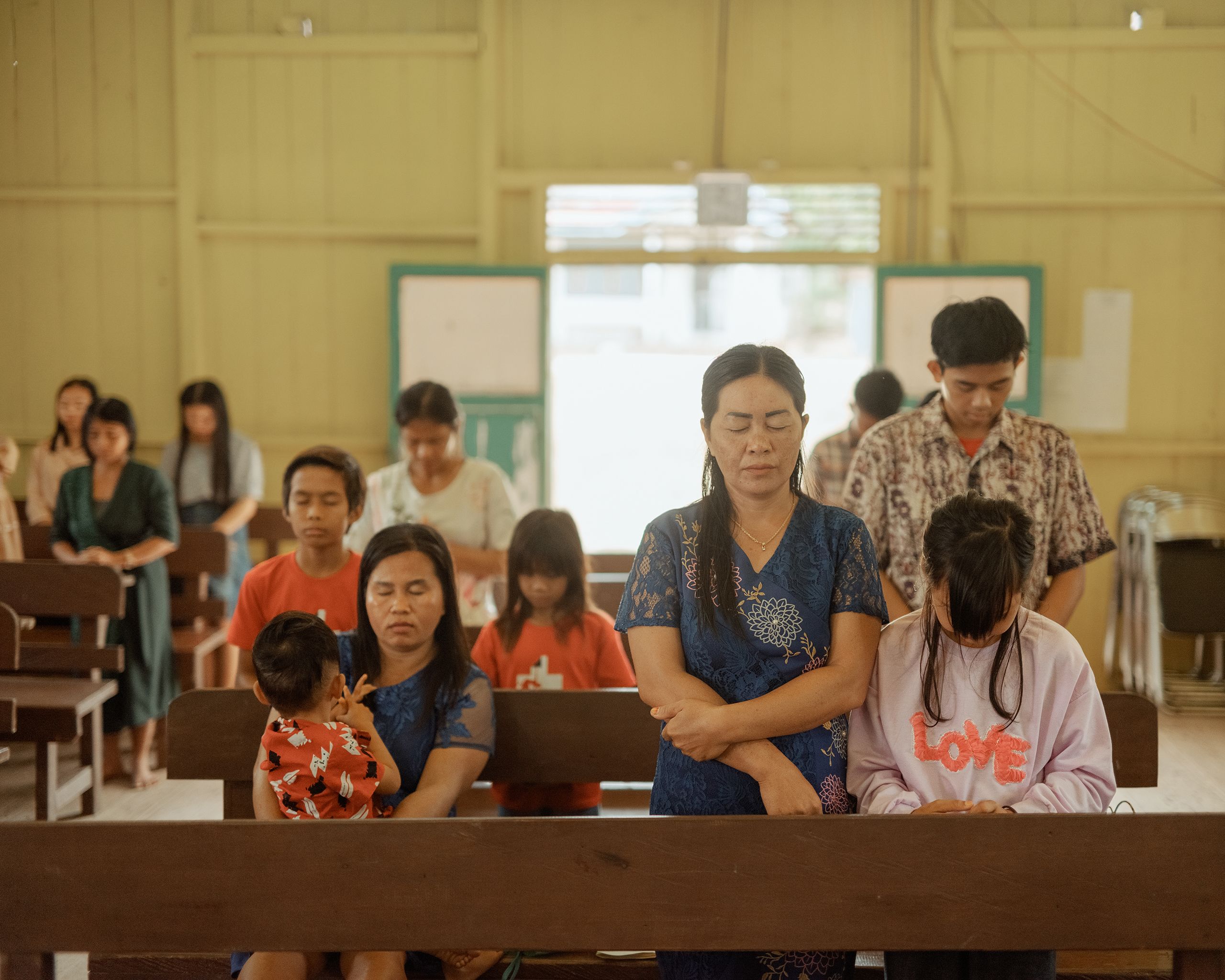

The small Christian community comes together for Holy Week in the Dayak village of Tumbang Olong in central Borneo.
The small Christian community comes together for Holy Week in the Dayak village of Tumbang Olong in central Borneo.
Around fifty pairs of flip flops and sandals patiently wait for their owners on the church’s vibrant forecourt. On Good Friday, the small Christian community of Tumbang Olong has assembled to pray for the health of one of its absent members. Sius suddenly fell ill after a heated discussion with the local authorities about the coal mine next to this village situated at the heart of the tropical forest of Borneo.
Tumbang Olong. Its monument to the equator line, its two sub-villages which are simply called Tumbang Olong I and Tumbang Olong II, led by two brothers, and its population belonging mainly to the Dayak indigenous group. Located in Kalimantan (the Indonesian part of the island), Tumbang Olong used to be reputed as a peaceful and remote village.
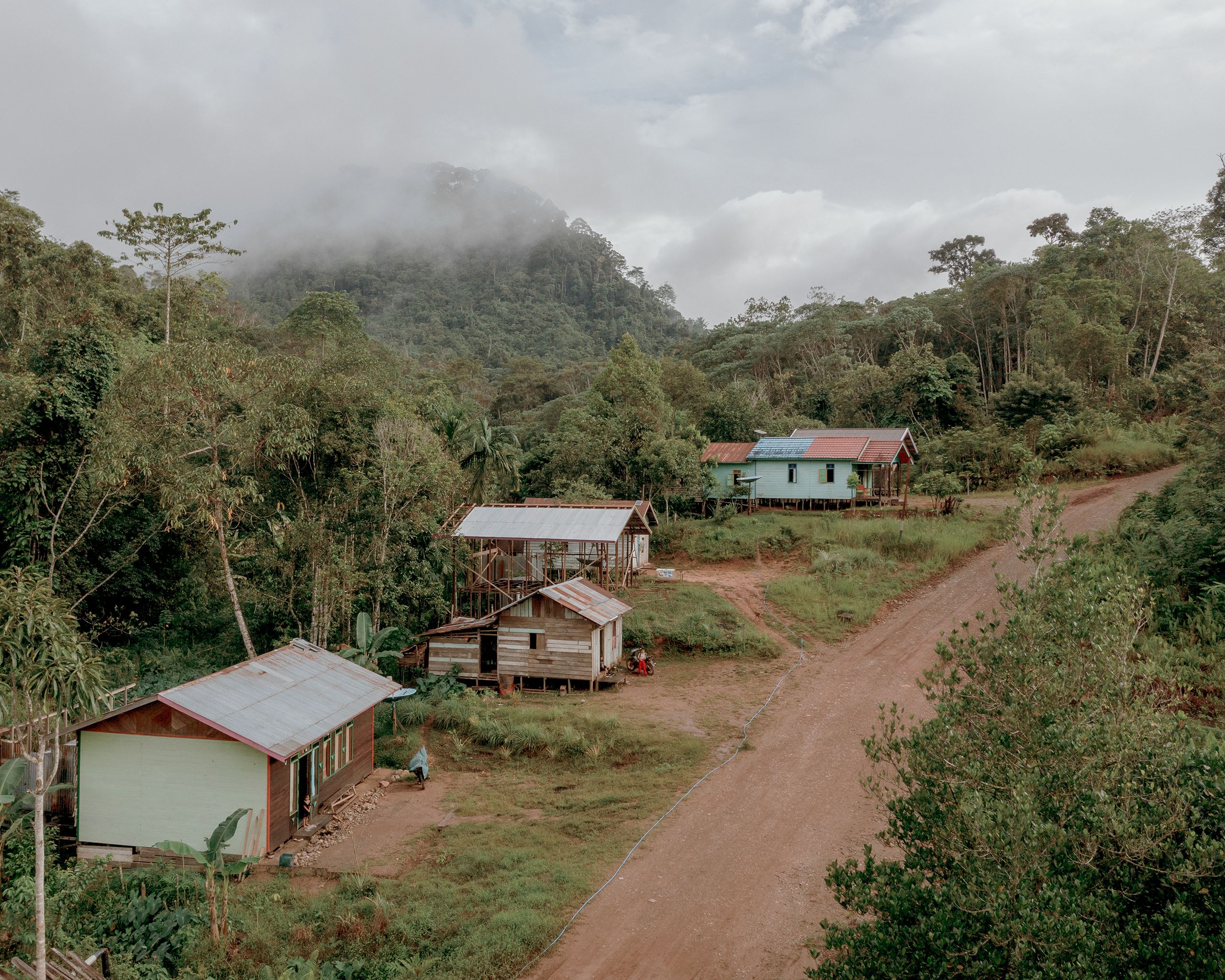
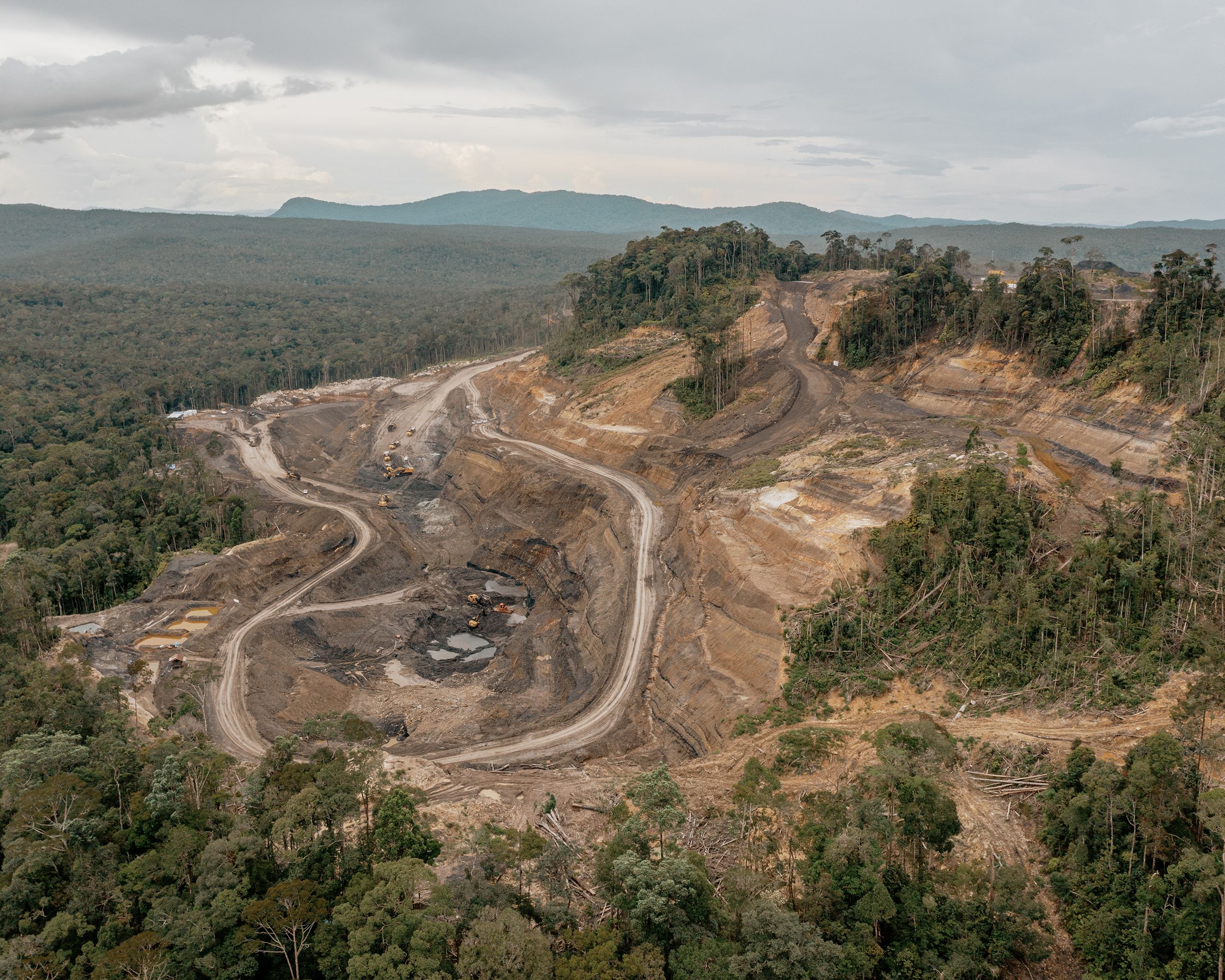


However, since 2019, the community has been divided by an operating coal mine situated around 20 km upstream. Its 900 inhabitants now live to the rhythm of the company Borneo Prima’s excavators and trucks. Borneo Prima operates on behalf of the conglomerate IMR Holding, which is domiciled in Zug. It carves a scar of soot and dirt on the bare top of the hill, and makes the whole community unwell.
At the end of the Easter mass on this interfaith land, the arrival of visitors asking questions does not go unnoticed. With the support of the Basel-based NGO Bruno Manser Fonds, Public Eye and the Indonesian environmental organisation Walhi spent a week on the ground to investigate the dirty practices of the intrusive Swiss mine.
The soot road
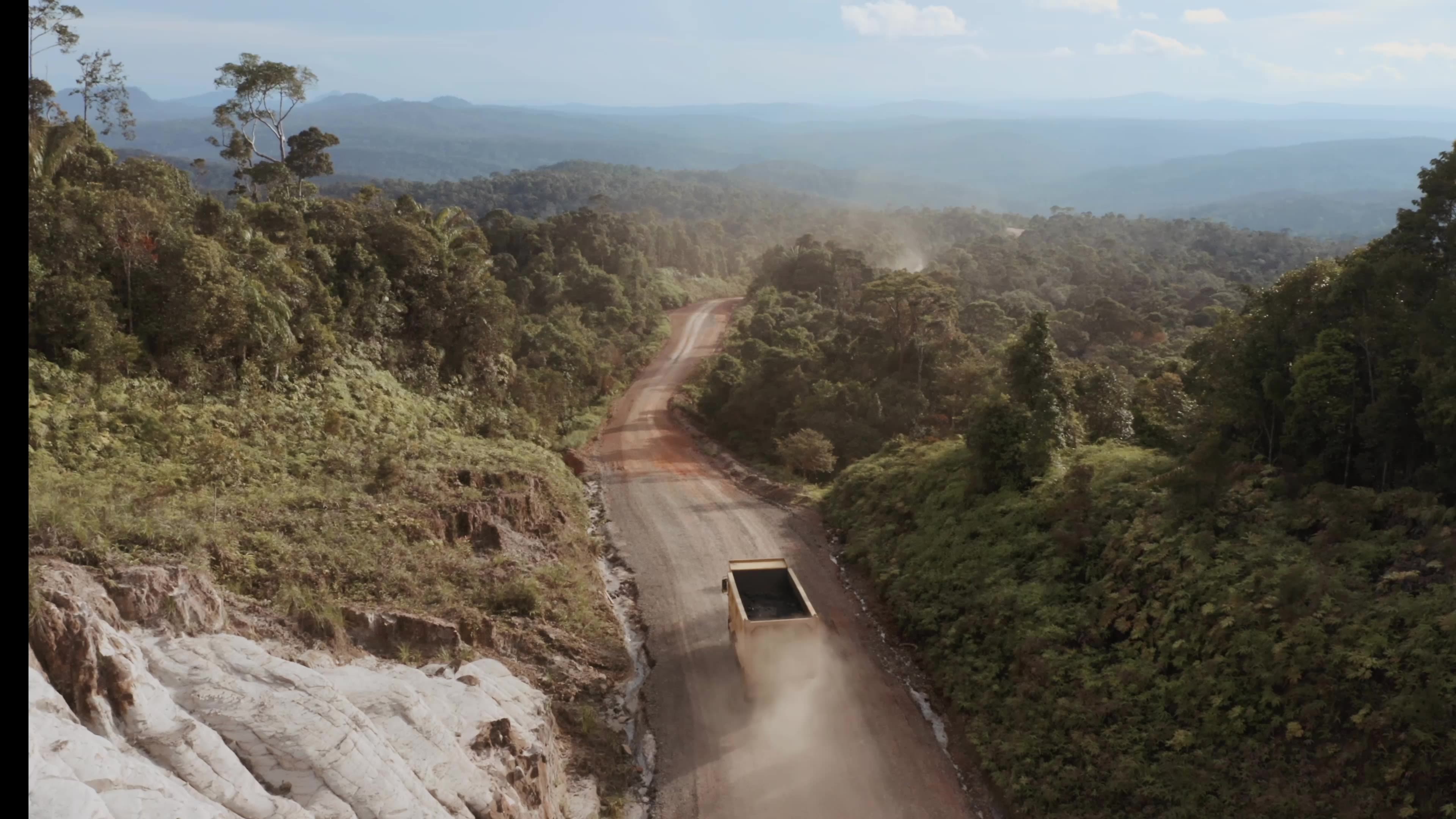
In Tumbang Olong, despite the pinang that discolours your gums and the sweetness of the tea that coats your mouth, tongues quickly loosen as soon as people hear the acronym ‘BP’, which is used here to refer to Borneo Prima.
The mining group’s bulldozers started by razing Mr Azis’ 300 rubber trees ‘with no consultation or prior notice’. They then seized the land where the soul of Dewi Sertika’s aunt has been laid to rest. The mine ended up contaminating the water source of the village’s first inhabitants, Manan and his wife Ilum, which supplies the whole community.
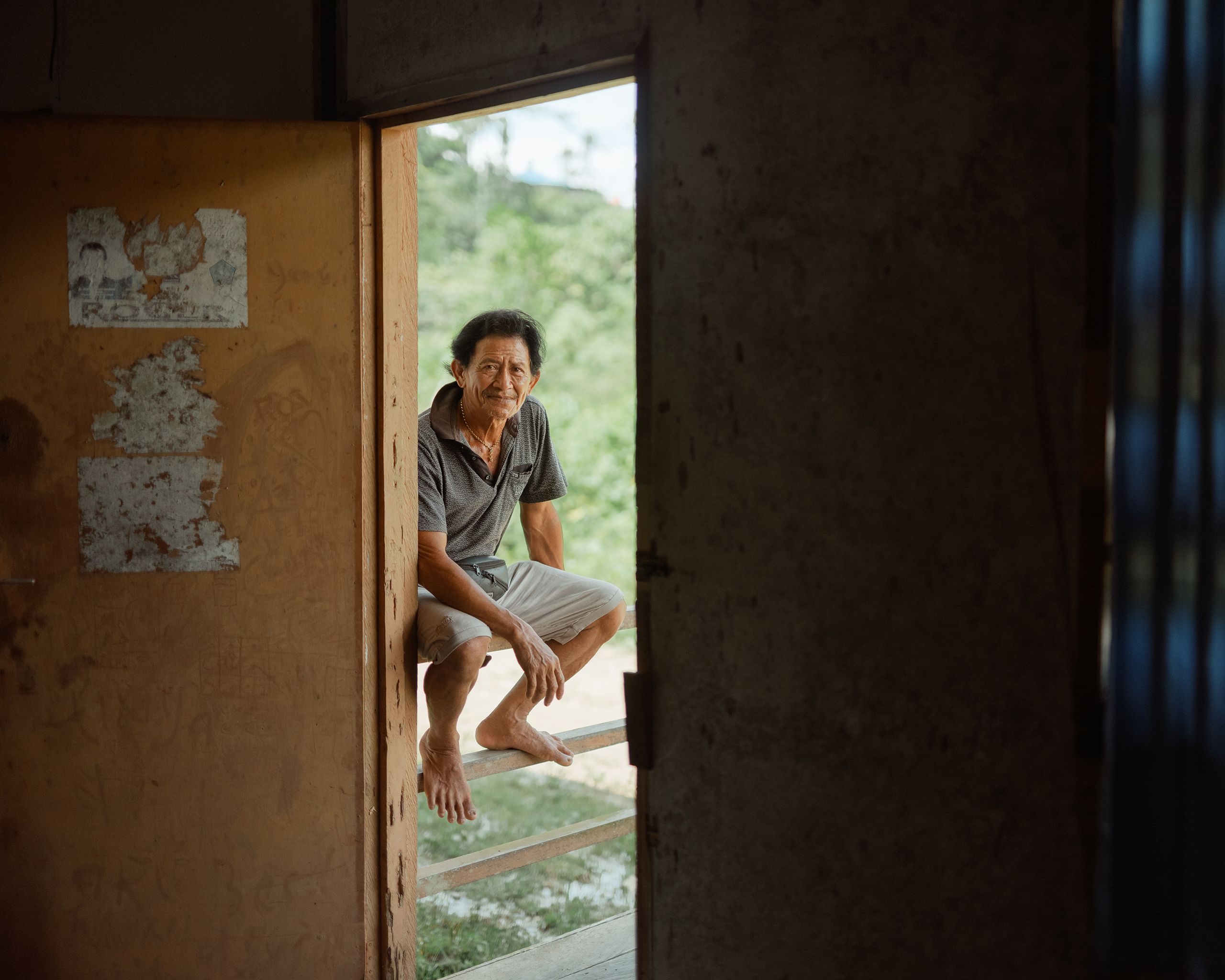
The coal miners unexpectedly cut down the 300 rubber trees of Azis. The caretaker of the forest camp has finally received compensation.
The coal miners unexpectedly cut down the 300 rubber trees of Azis. The caretaker of the forest camp has finally received compensation.
The IMR group’s mine produces 2.3 million tonnes of coal a year, exclusively transported by truck on a bumpy 140km road that is conducive to accidents up to the water terminal at Muara Laung. From there, coal is sent in convoys on large, sluggish barges along the river Barito. It is then dispatched to international markets or the Island of Java, where IMR owns a steel plant.
However, before this the trucks have to cross Tumbang Olong I. They form an incessant ballet of tens of thousands of vehicles per year that spill piles of coal and raise clouds of dust, when they’re not leaving a trail of wrecks on the road behind them. Manan, the former spiritual Damang guide of the Dayak community, summarised the overriding feeling:
“we’re being treated like peanuts forgetting their shells”.
Pariahs in their own land.
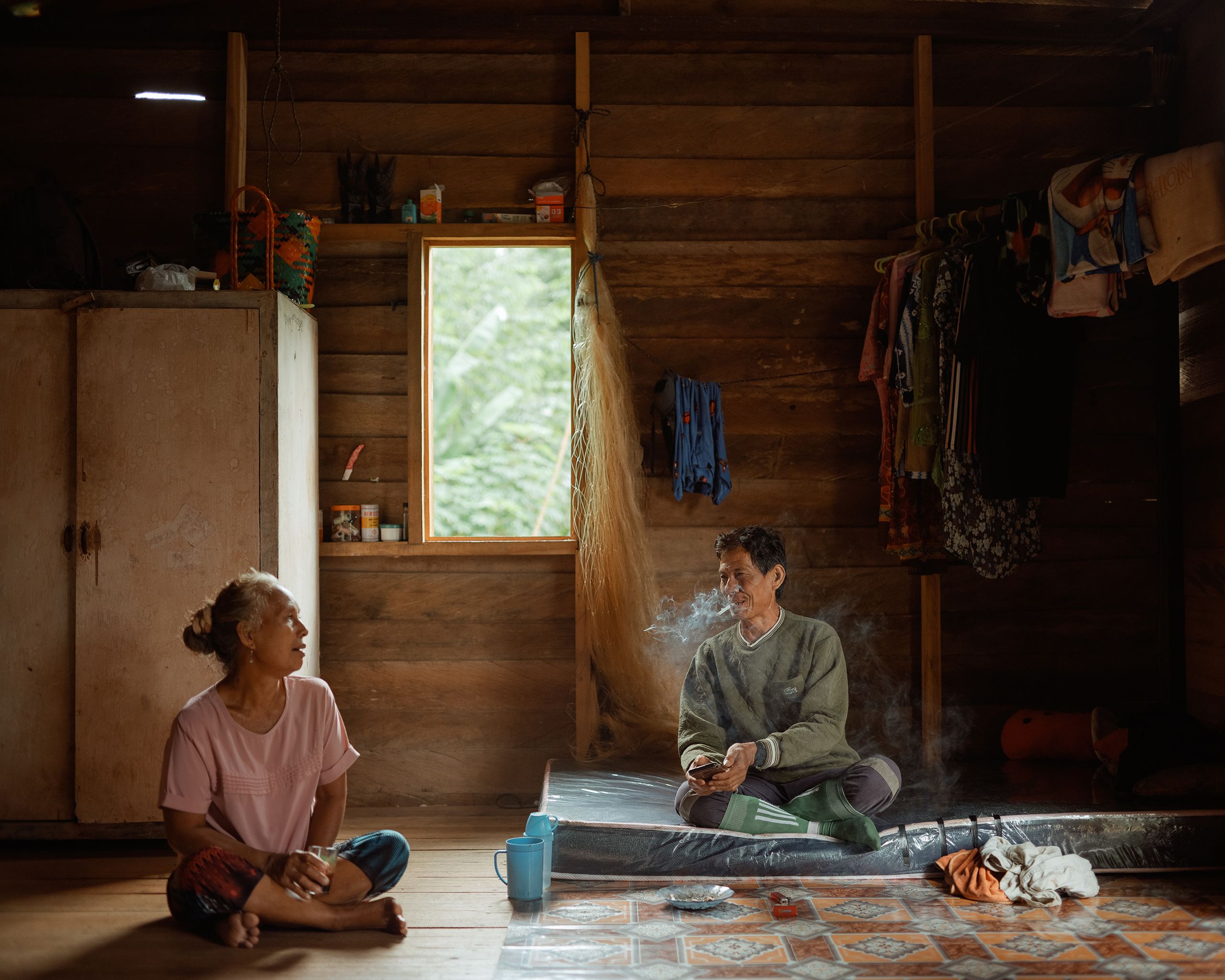
Illum and Manan were the first inhabitants of Tumbang Olong II. Manan was the Damang of the Dayake community, a spiritual guide sharing his power with the village chief and the Indigenous Council.
Illum and Manan were the first inhabitants of Tumbang Olong II. Manan was the Damang of the Dayake community, a spiritual guide sharing his power with the village chief and the Indigenous Council.
When leaving the church, Dewi Sertika’s head is full of anecdotes “The authorities say there is no problem. But the chief of Tumbang Olong II did not want to drink my water”. For this young mother, as for the overwhelming majority of the community, rivers remain the source of water for all needs of daily life – consumption, personal hygiene, laundry and cleaning. Since the mine opened, a whole way of life has had to be reinvented. This is particularly the case in the rainy season, when water flows carry coal and dust all the way to homes, lungs and stomachs.
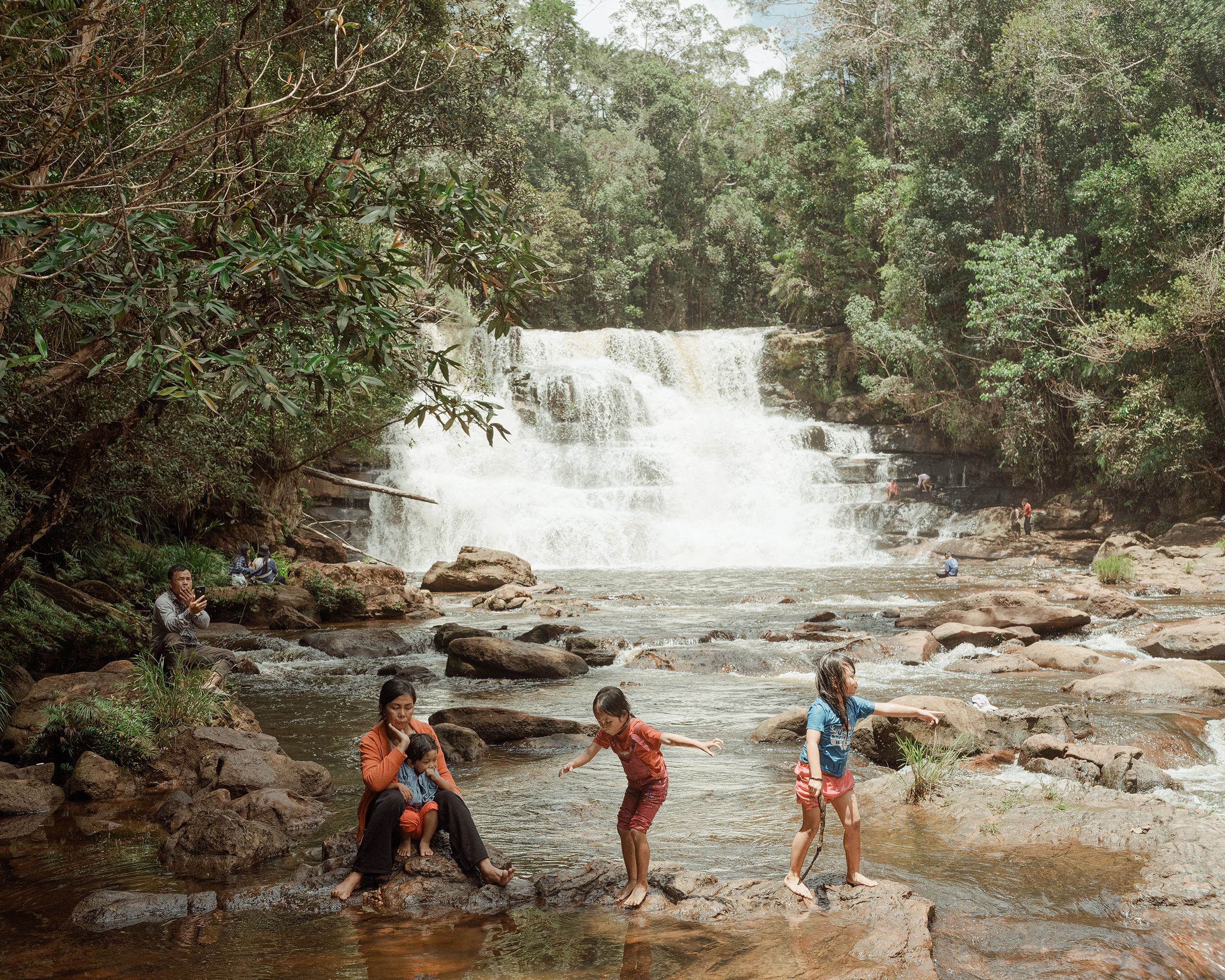
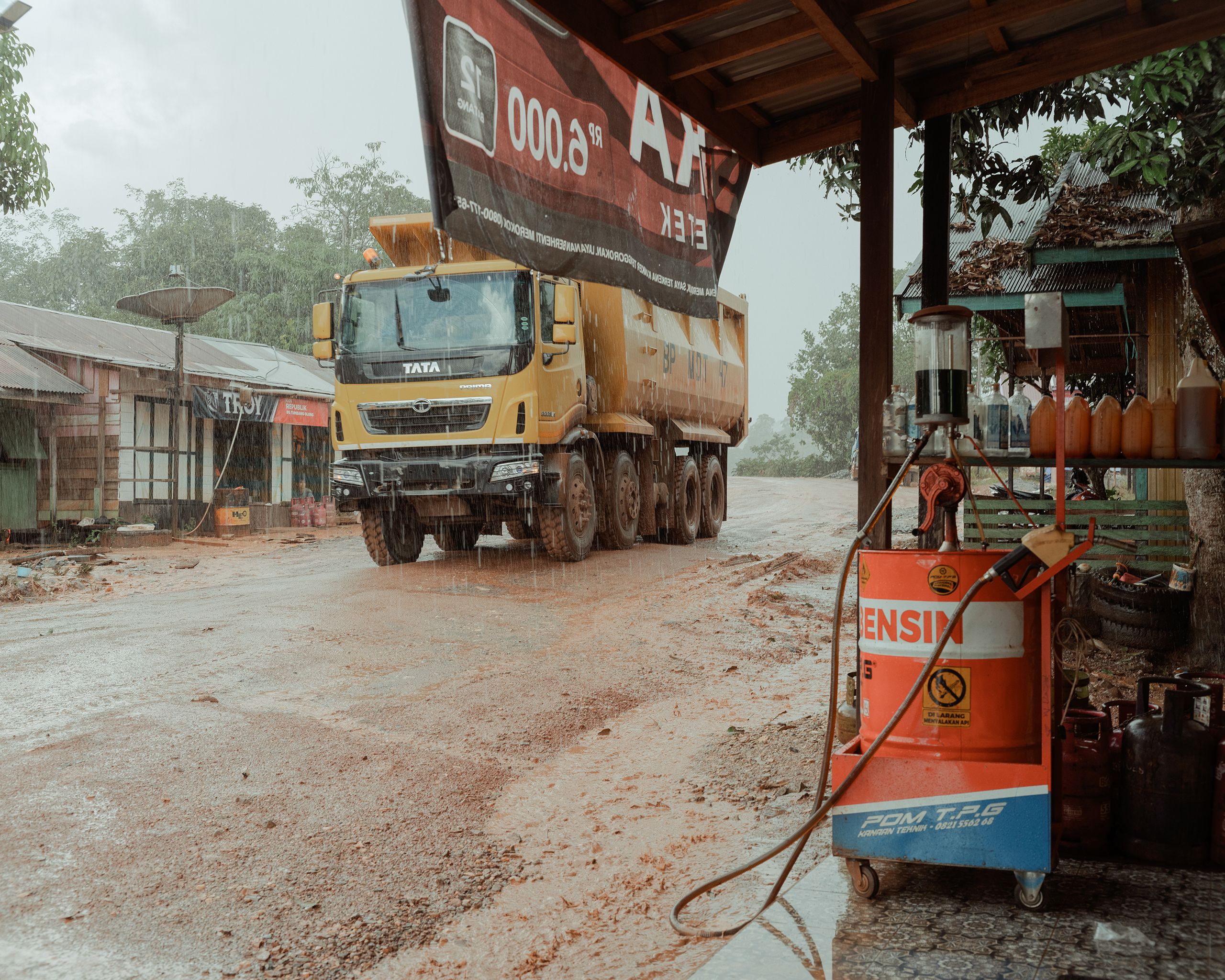
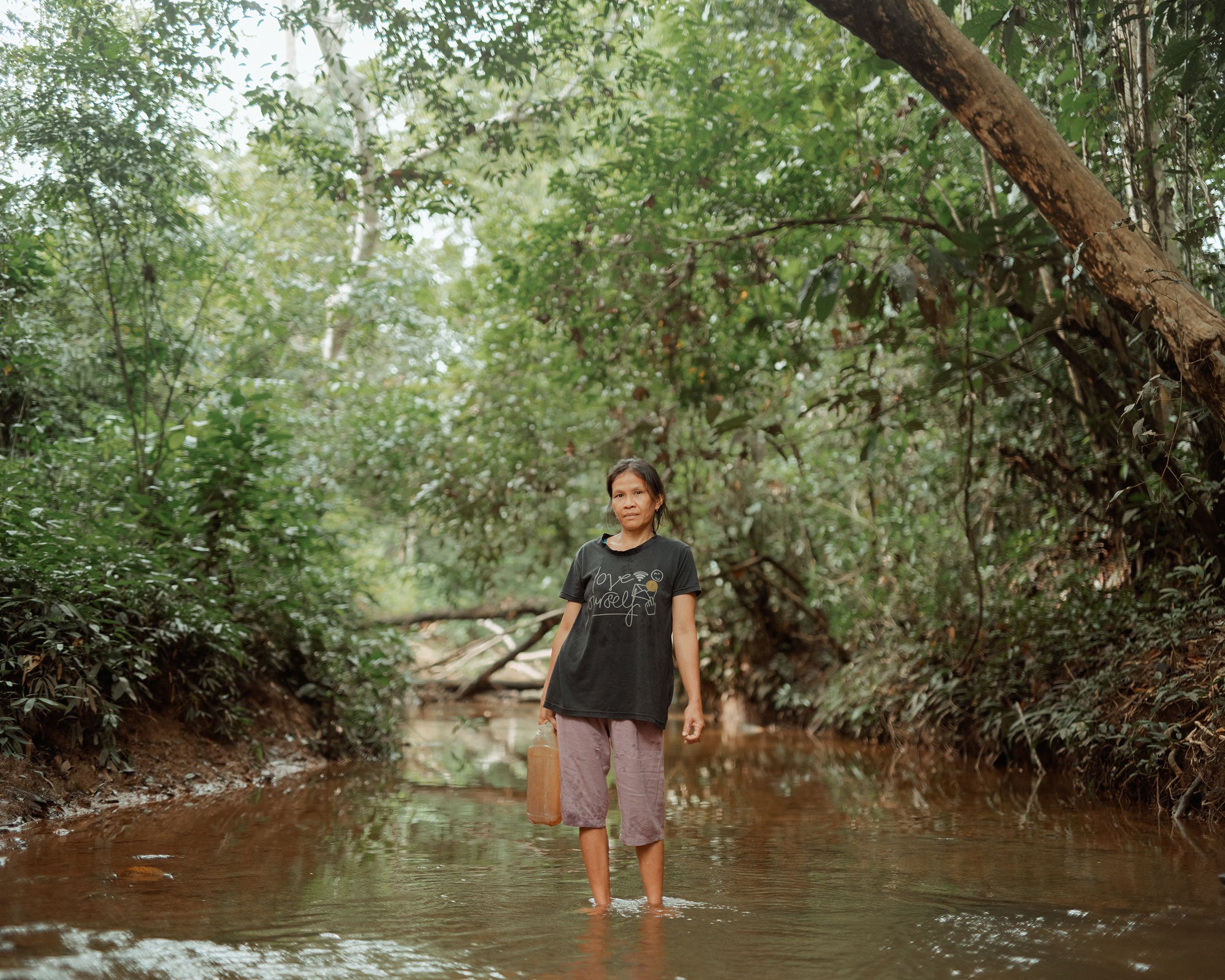



For her daily needs, Dewi Sartika draws from the small river behind her house in Tumbang Olong. The water is sometimes very dirty, as mud from the road flows directly into the river.
For her daily needs, Dewi Sartika draws from the small river behind her house in Tumbang Olong. The water is sometimes very dirty, as mud from the road flows directly into the river.
Since it arrived, BP has been engaged in an arm-wrestle with the Dayak community. Unable to force the mining company to respect the environment, the community has been asking it at least to supply drinking water to Tumbang Olong via a system of tanks. The miners are turning a blind eye and since the first critical reports by the Bruno Manser Fonds were released in early 2022, there has been radio silence from IMR, the multinational that employs them. In fact, BP only seems to react when the inhabitants organise blockades of the road it uses to transport its coal.
We obtained a copy of its environmental impact report, which was produced and signed under the responsibility of its director in January 2013. In the report, BP analyses in minute detail its demographics as well as the potential for conflicts in its neighbourhood. It establishes that 68% of members of the community depend on agriculture to survive, emphasizing that the Murung and Barito rivers are used for ‘drinking, bathing and washing’ and anticipating a ‘significant negative impact’ on the quality of water. The company goes as far as promising to install a sediment pond to reduce erosion and to limit acid mine drainage. Ten years after the report was written, we did not see the slightest indication of this at site. Even more surprising is that BP recognises that it is on the brink of operating on the territory of protected species such as the long-tailed macaque, the rhinoceros hornbill (a species of bird with a horn mounted on top of its large beak) or the blue-eared kingfisher. Yet no measure is envisaged to preserve their habitat. The reason given is that they are due to benefit from a reforestation programme during and after mining operations.
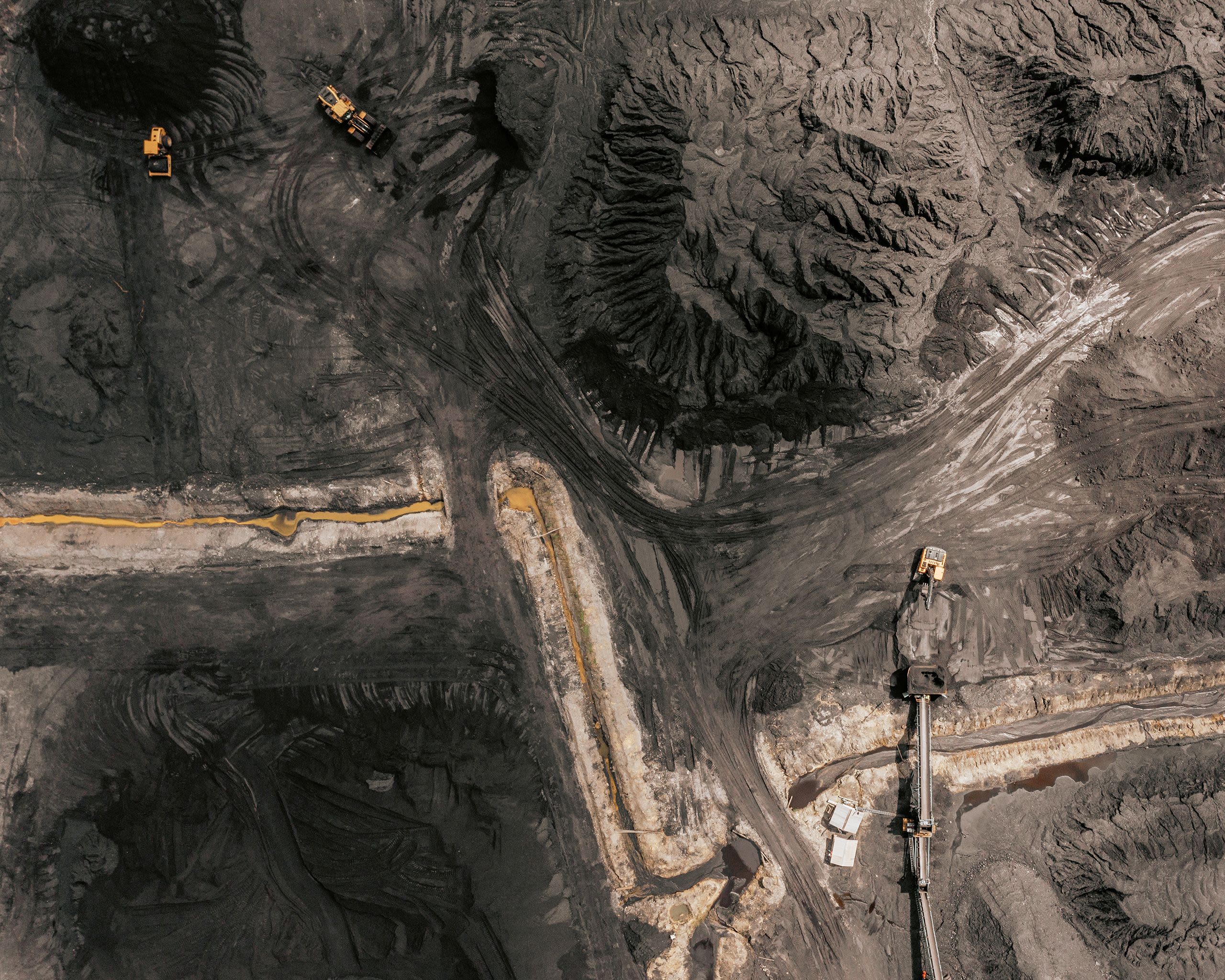
The coal is stacked on the site of the Muara Laung terminal, before being loaded on barges along the Barito River.
The coal is stacked on the site of the Muara Laung terminal, before being loaded on barges along the Barito River.
For their part, the local authorities do not seem concerned about health statistics. In 2022, respiratory illnesses constituted the main complaint in consultations at the local health centre, according to an internal report we were able to review. The health centre receives patients from the five villages around the mine. Since the opening of the mine in 2019, the statistics have consistently deteriorated, and respiratory problems now constitute the cause for 30% of medical appointments. The head of service considers that the only relevant factor is “the effect of climate change”, which increases rainfall. Nevermind if the inhabitants of Tumbang Olong I and II, the villages closest to the mine, are over-represented in the statistics. “BP anticipates problems linked to the dust caused by trucks by spraying water on the hauling road” she explains in what appears to be strange “medical explanation”.
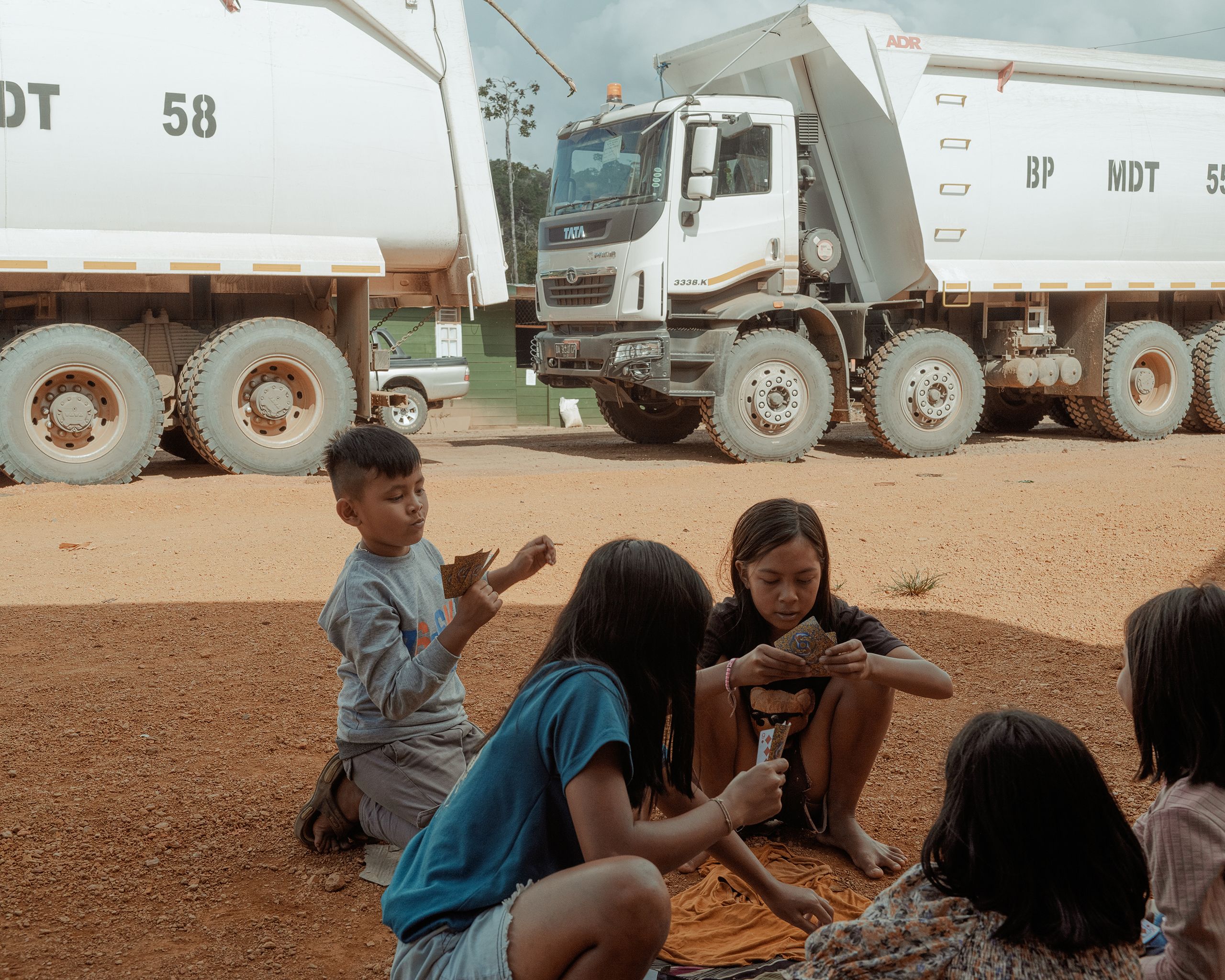
The workers' camp of Borneo Prima is located a few dozen kilometres from Tumbang Olong. The site is permanently jammed with a large number of trucks from the mining company.
The workers' camp of Borneo Prima is located a few dozen kilometres from Tumbang Olong. The site is permanently jammed with a large number of trucks from the mining company.
Fault lines
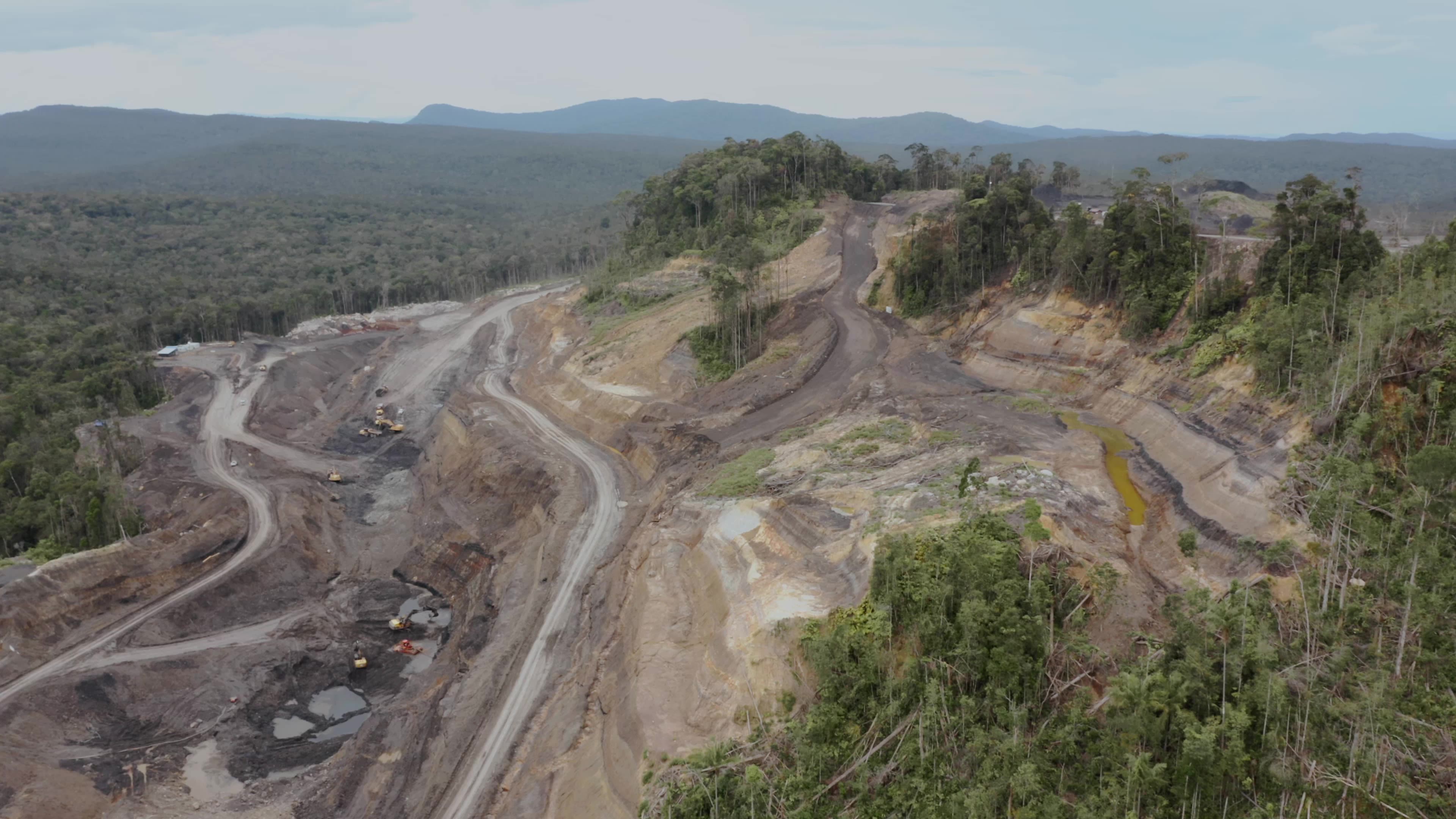
Water, air and crop pollution is a recurrent problem in Kalimantan, a region which has been devastated by the timber trade, the palm oil industry and – now – coal mines. Teams from the environmental Jakarta-based NGO Jatam and Greenpeace took tens of samples from the water courses in the mining regions. The results are devastating. In nearly two-thirds of samples collected by Jatam, the water contains levels of aluminium over 0.5ppm. Aluminium is harmful to rice crops at such level.
When contacted by Public Eye, the NGO cited as causes the lack of regulation and the absence of political will from the state to carry out effective monitoring. Mining concessions cover 10% of the surface area of the country, but “there are still no limits on the presence of heavy metals such as aluminium, " says its spokesperson Ki Bagus Hadikusumo. “And the standards in relation to the acidity of watercourses are too low to protect agriculture and fishing [the main livelihoods of rural communities].”
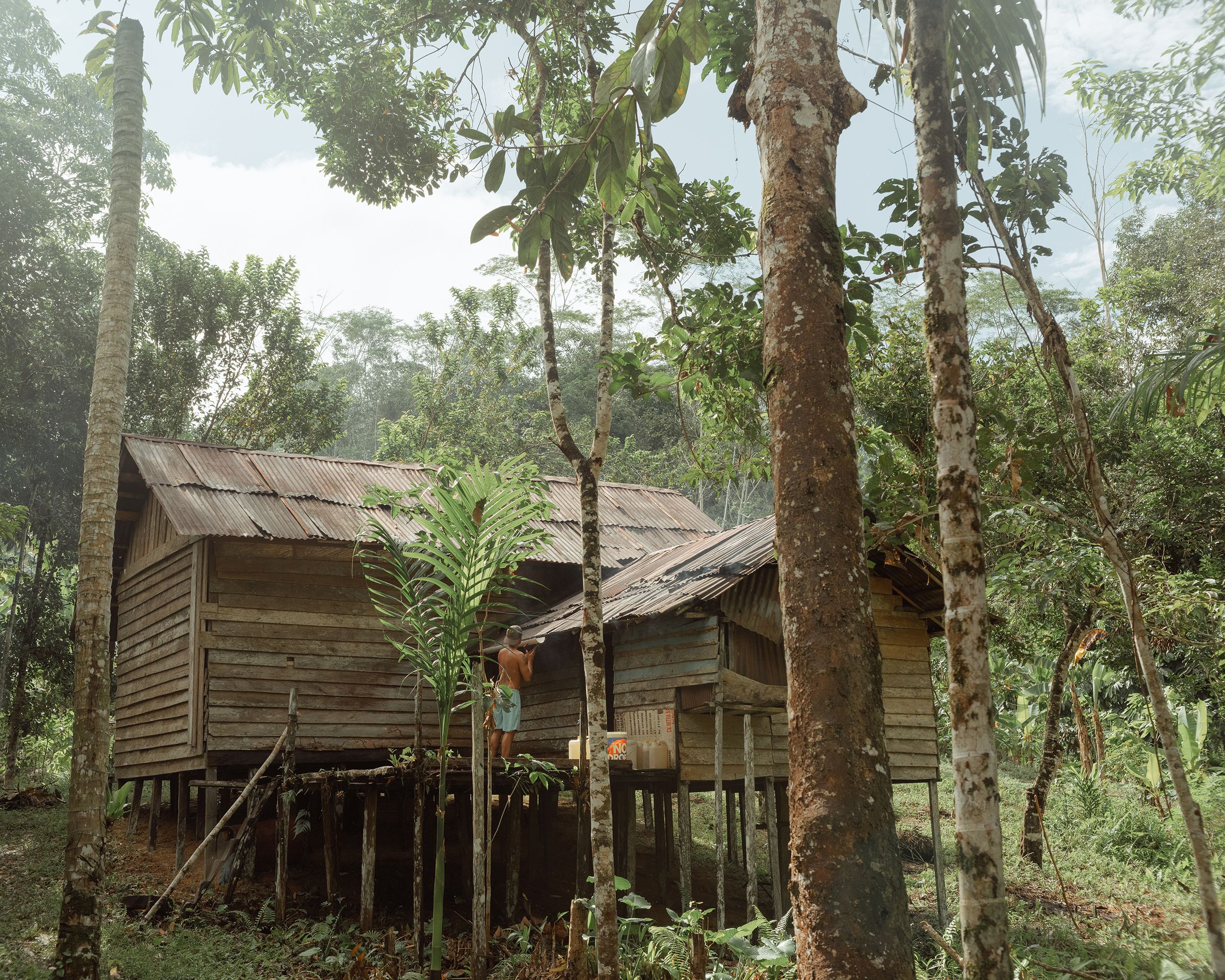
In Tumbang Olong, a village without electricity and running water, most houses are wooden huts.
In Tumbang Olong, a village without electricity and running water, most houses are wooden huts.
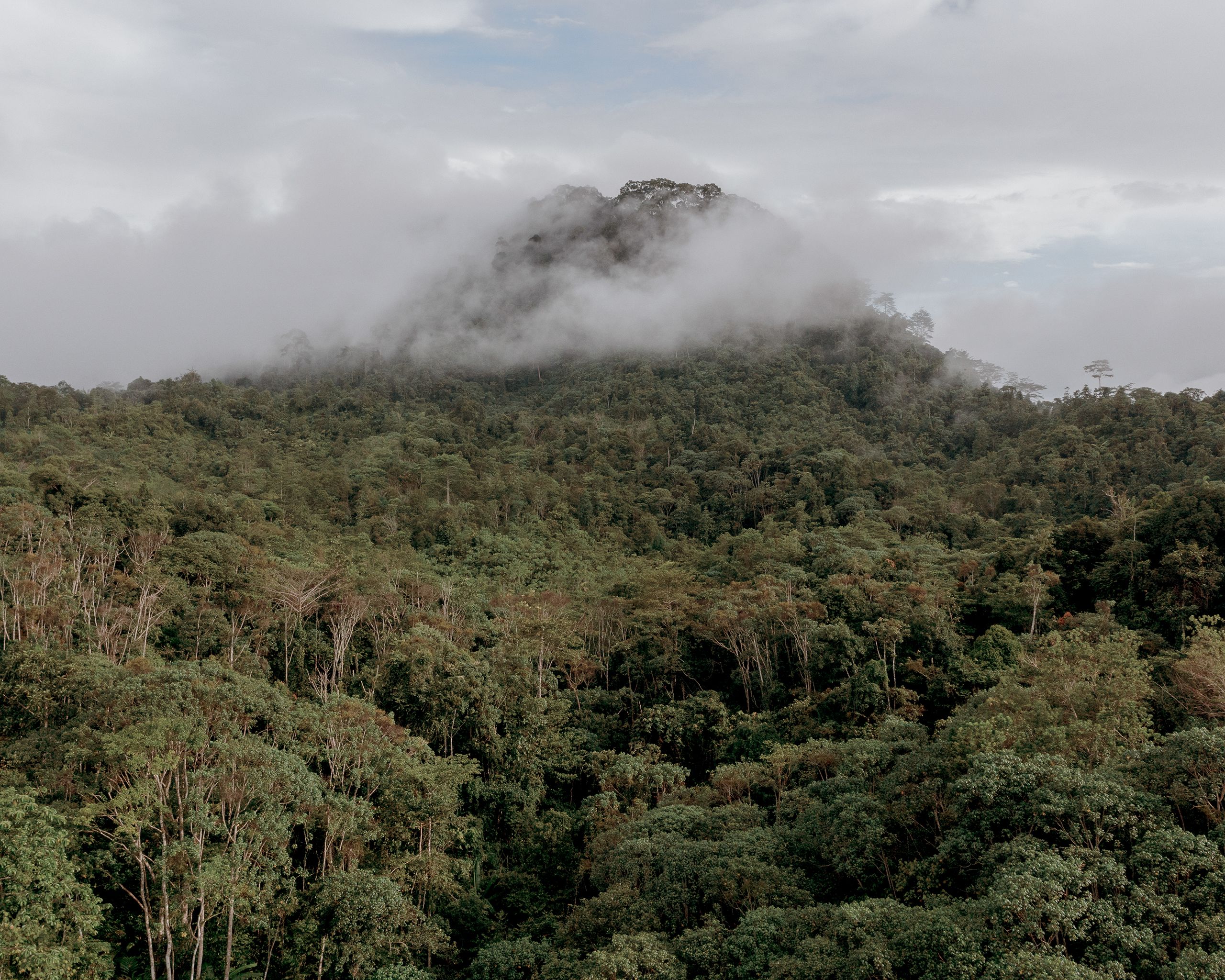
The rainforest of Borneo is one of the largest in the world and is home to a unique ecosystem, of which the orangutan is the most symbolic representative.
The rainforest of Borneo is one of the largest in the world and is home to a unique ecosystem, of which the orangutan is the most symbolic representative.
The heart of Borneo is home to the second largest rainforest in the world measured by surface area. The rainforest provides for the survival of a unique ecosystem comprising over 6,000 indigenous plants and numerous endangered species such as orangutans or gibbons. Dayak communities used to be mostly nomadic and lived isolated from the outside world. In the late 1990s, the future inhabitants of Tumbang Olong started getting closer to the roads to establish themselves while preserving their traditions and a culture of word of mouth. The Dayak environmentalist Thomas Wanly summarises: “Territory division is defined by sight... through mountain ridges or natural channels. A big tree can distinguish two properties.” The arrival of mining companies brought another reality.
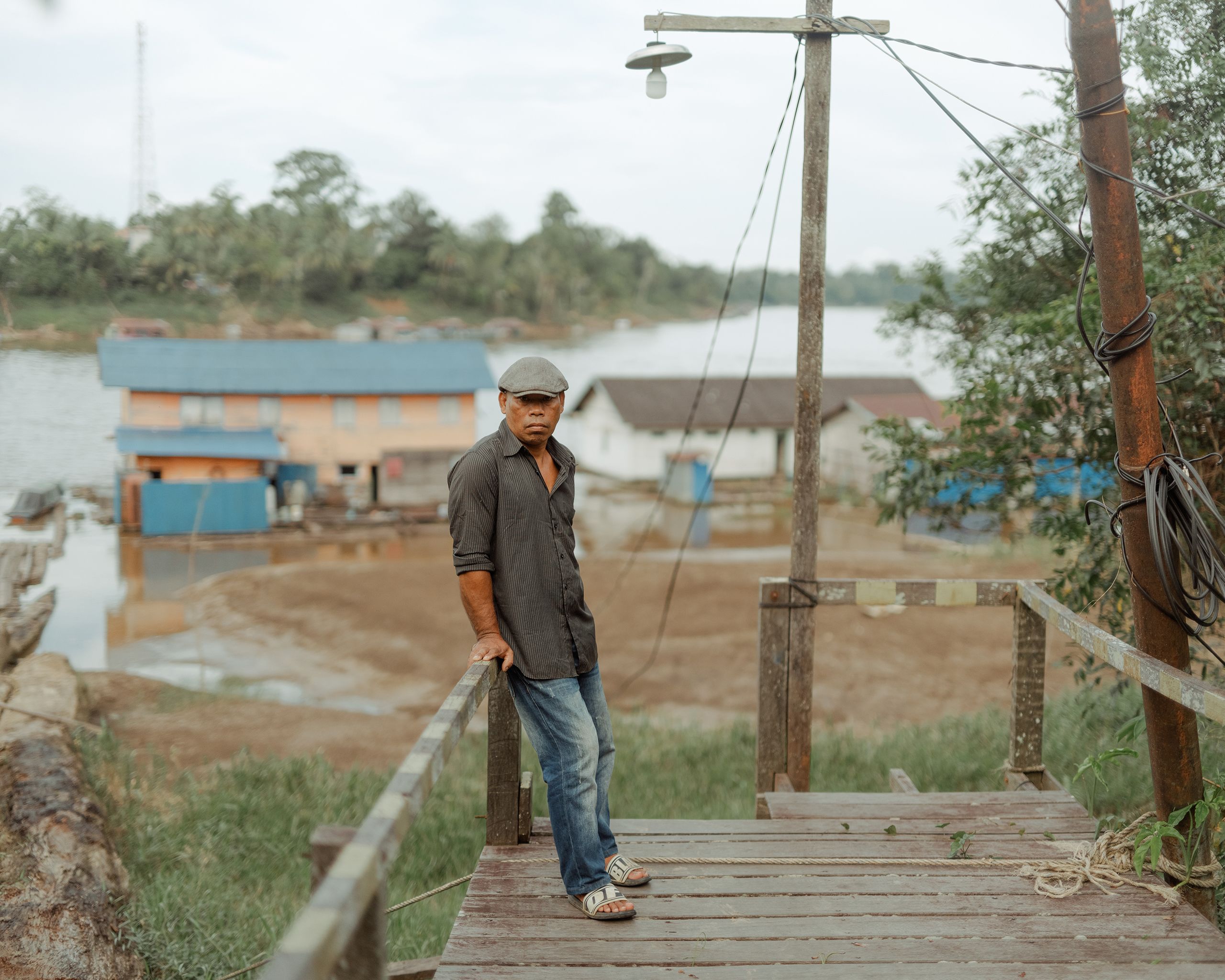
Thomas Wanly is one of the fiercest opponents of the company operating the coal mine. The legal officer denounces several cases of land grabbing from the Dayak people.
Thomas Wanly is one of the fiercest opponents of the company operating the coal mine. The legal officer denounces several cases of land grabbing from the Dayak people.
Legal officer Thomas Wanly is a collaborator with the inter-governmental programme Heart of Borneo, which aims to preserve biodiversity and local populations. He worked on five cases related to alleged land grabbing by Borneo Prima. His last dossier ended – by way of reward – with his client being hired as a cook in the mining operations. However, the lawyer continues his Sisyphean task, despite a recent stroke that left part of his body paralysed. For him, the most appalling of all is the fact that the Dayak’s word of mouth tradition provided a legal loophole that Borneo Prima cynically exploited to “grab their land”. In exchange, the owners sometimes receive compensation and the promise of employment…which only rarely materialises.
Public Eye was able to meet several BP employees, including those whose names have been amended to avoid reprisals against them. Anang* has tanned skin and forearms that are clearly used to gripping bolts. Like others in the community, he applied for a job with BP, to earn the equivalent of one Swiss franc an hour. This is half as much as the competition pays, according to Anang: “The salaries are not good here. People work with a cigarette hanging out of their mouth and without a seat belt. This year, I’ve already seen a dozen accidents resulting in fractures or concussions”.
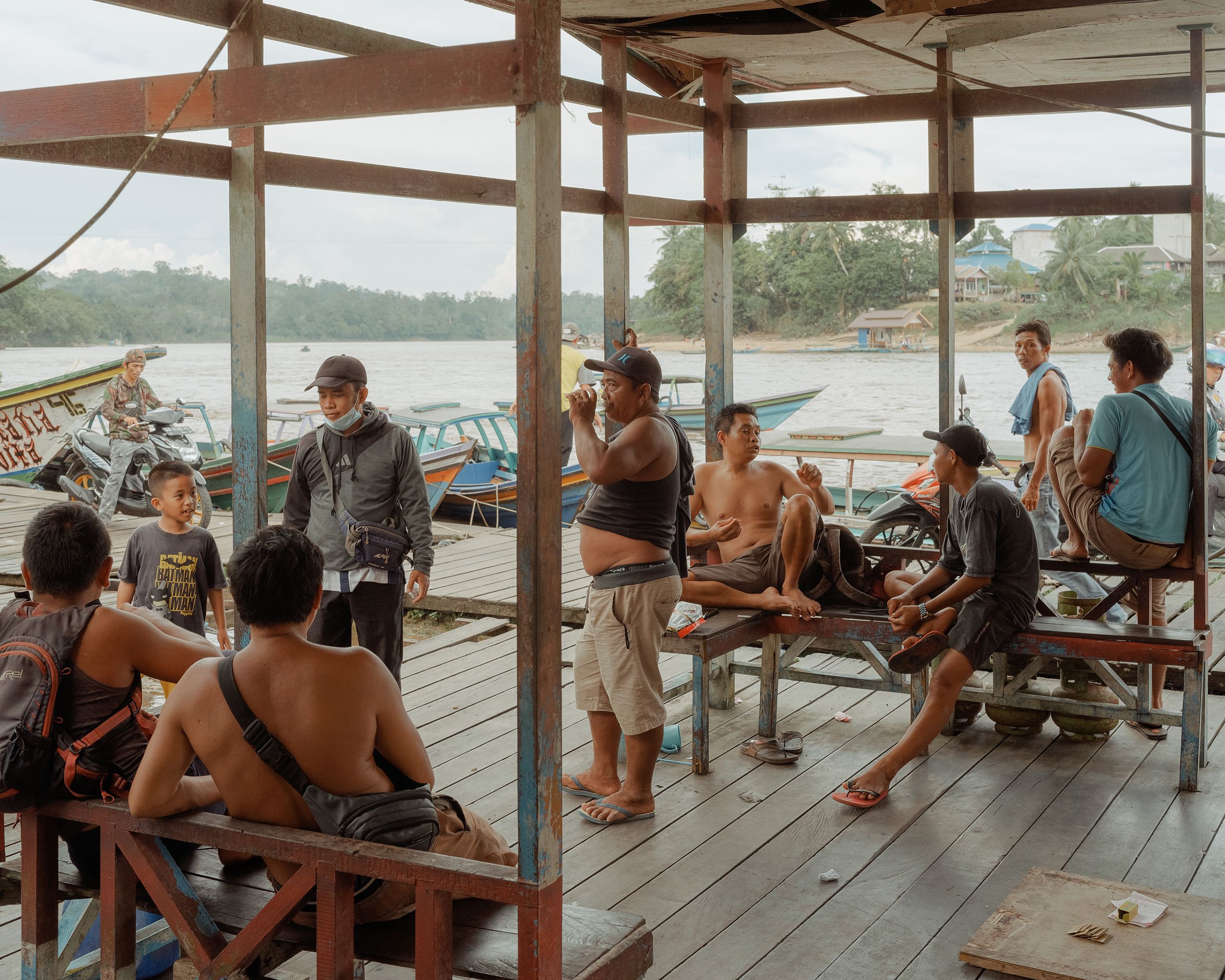
The coal of Borneo Prima is transported towards the sea through the river Barito. The port of Puruk Cahu also welcomes fishermen and gold miners.
The coal of Borneo Prima is transported towards the sea through the river Barito. The port of Puruk Cahu also welcomes fishermen and gold miners.
Despite everything, many still want to work for BP. Raya wears a worn-out uniform and says that he “would return even to collect the garbage, whatever. But the company thinks [he has] passed the productive age”. It’s the paradox of mining. At Tumbang Olong, everyone agrees to criticise the negative externalities that cause the countryside to empty, but the mine is also the only source of employment in the region. According to our estimates, BP employs around 15 Dayak people, namely barely 5% of its workforce. In its 2013 environmental impact report the company promised to reach 65%. From the community’s wooden huts, the question of the mining company’s “unkept promises” comes up repeatedly.
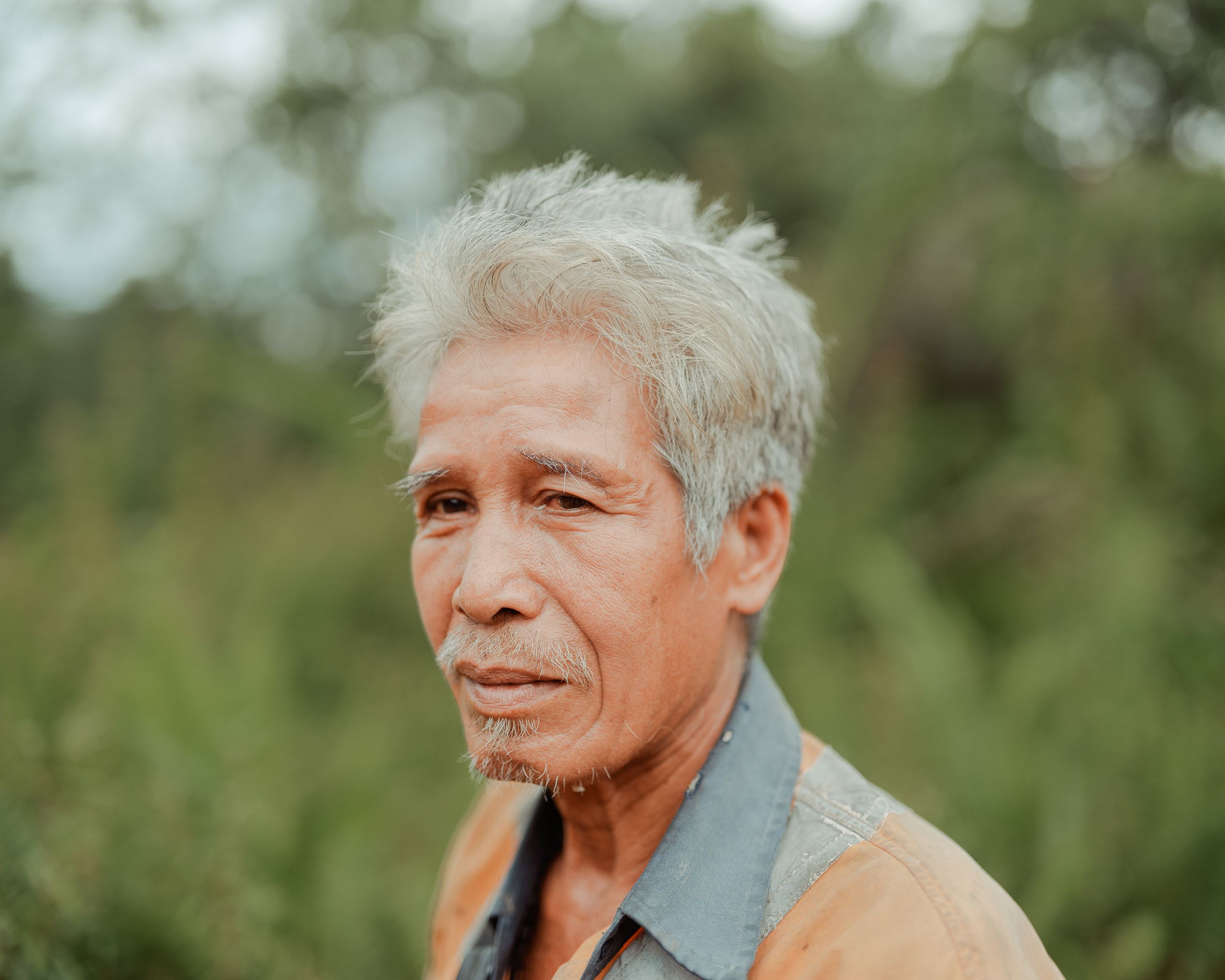
Raya still wears a used uniform from Borneo Prima, one of the two employers in the region. Although he is has passed the "productive stage of life", according to the mining group, he is desperate to find a source of income.
Raya still wears a used uniform from Borneo Prima, one of the two employers in the region. Although he is has passed the "productive stage of life", according to the mining group, he is desperate to find a source of income.
Swiss companies active in the country could also soon be in a position to circumvent the Indonesian courts. Following the free trade agreement signed in 2018 and approved by popular vote in 2021, Switzerland recently concluded a new Bilateral Investment Treaty (BIT) with Jakarta. The agreement seeks to protect the interests of its companies by enabling them to circumvent the national justice system to directly address a private court. These rights are not accompanied by any obligations for investors. There a no binding provisions creating a responsibility to respect human rights and environmental standards in the agreement.
The invisible state
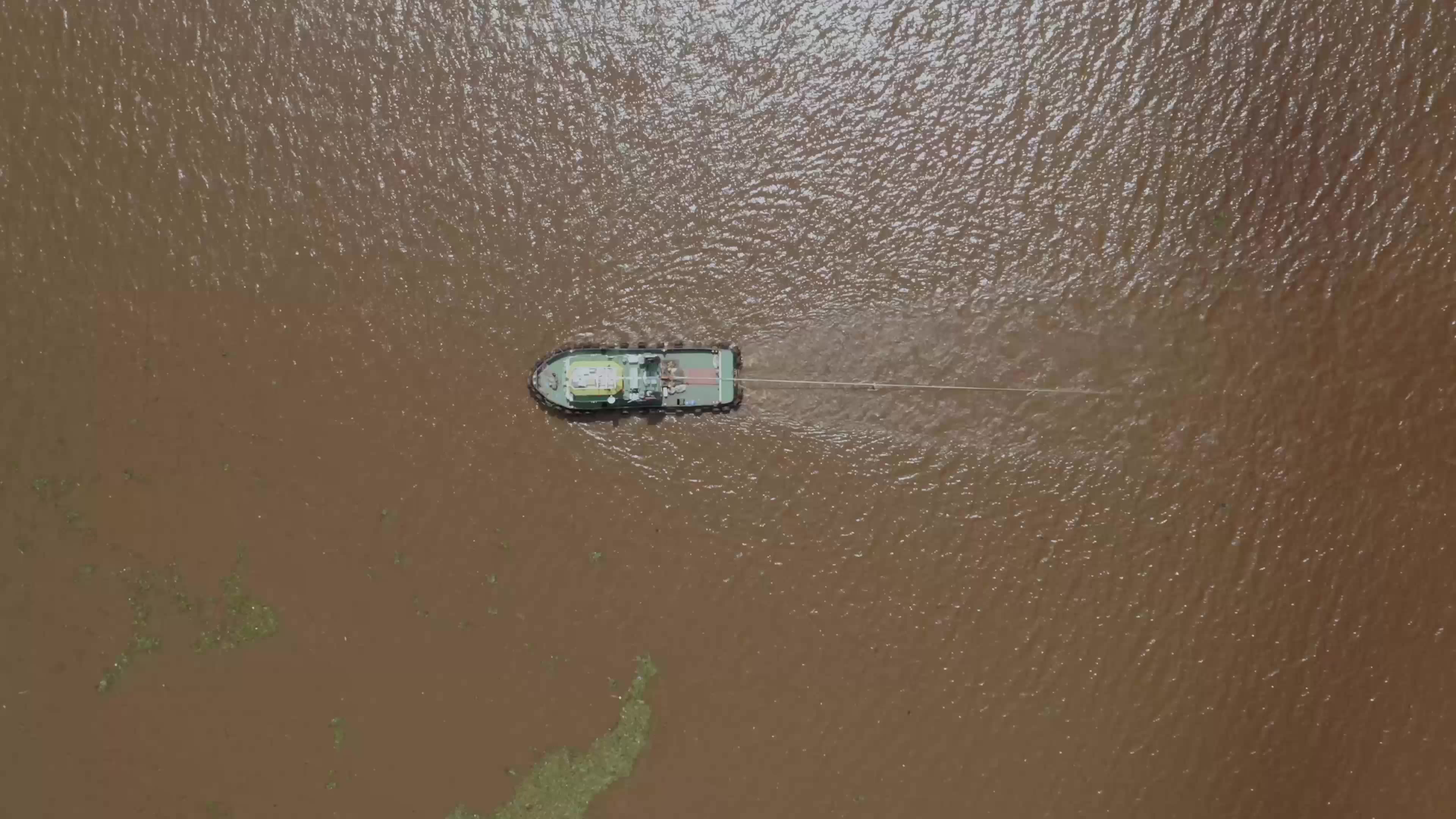
The Indonesian government’s strategy of renunciation is a blot in a country used to determining its own destiny – as can be seen with its declaration of independence following the Second World War, the creation and imposition of a national language in a territory parcelled into 17,000 islands and some 700 languages, or the pursuit of large demographic projects (such as the state’s ‘transmigrasi’ programme and its 2.5 million displaced people towards the least populated islands in the early 1980s) or food security (‘Mega Rice’ or more recently ‘Food Estate’).
In its Hungry Coal report, Jatam describes a country in perpetual conflict between the interests of the coal industry and its fight to provide food for a growing population – numbering nearly 300 million in 2030. The mines take up the most fertile land entering – on increasingly cramped land – into direct competition with rice cultivation, which forms the basis of the local food supply.
Coal mines in Indonesia
The 998 coal mines in Indonesia are notequally distributed in the provinces of the country. Most of the mines are in Kalimantan, the Indonesian part of the Island of Borneo.

Coal is transported by truck to the river terminal, then loaded onto barges before finally being transported by sea.
Mine operated by PT Borneo Prima and village Tumbang Olong
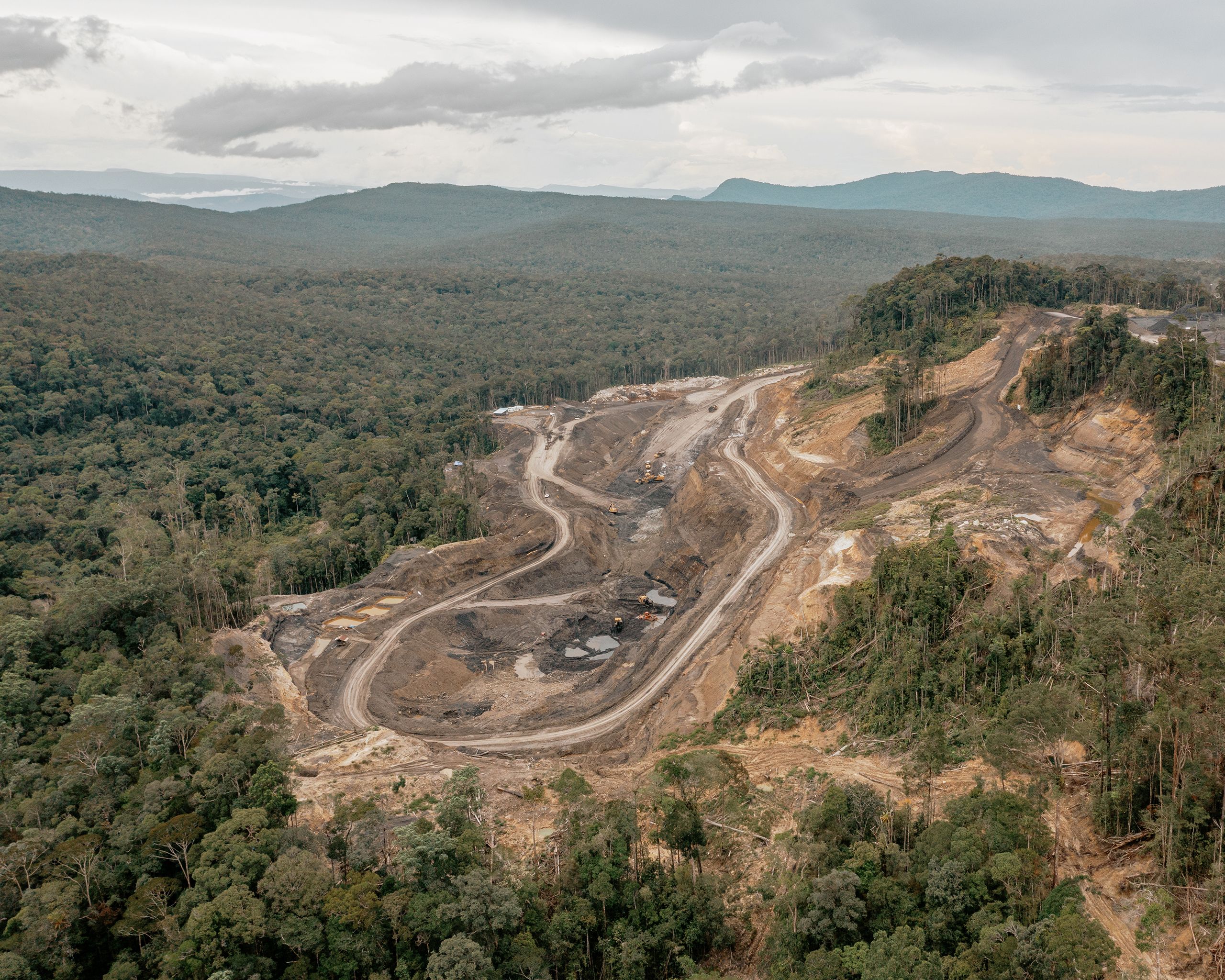
Coal terminal Muara Laung
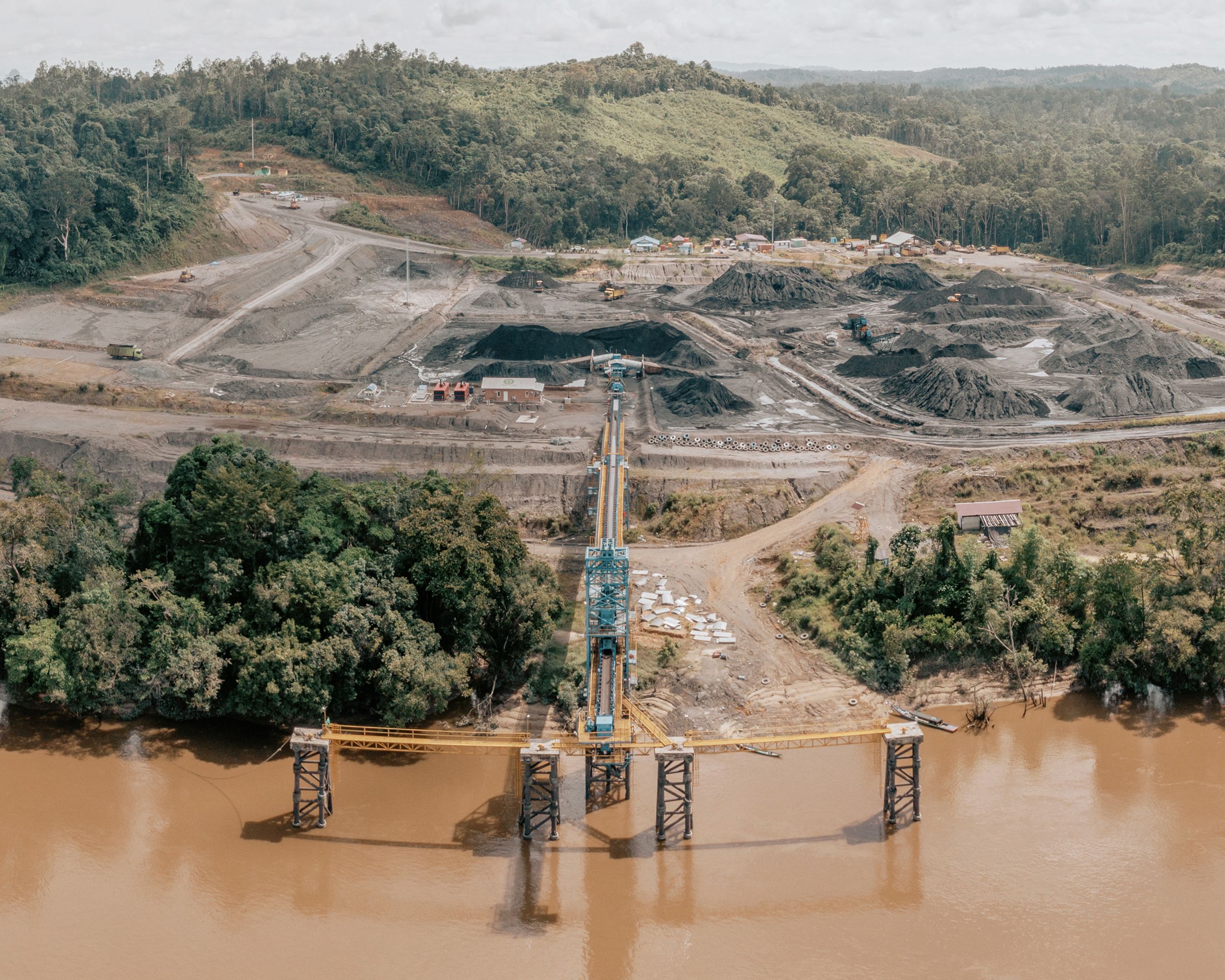
Mine KEL, owned by Mercuriaa
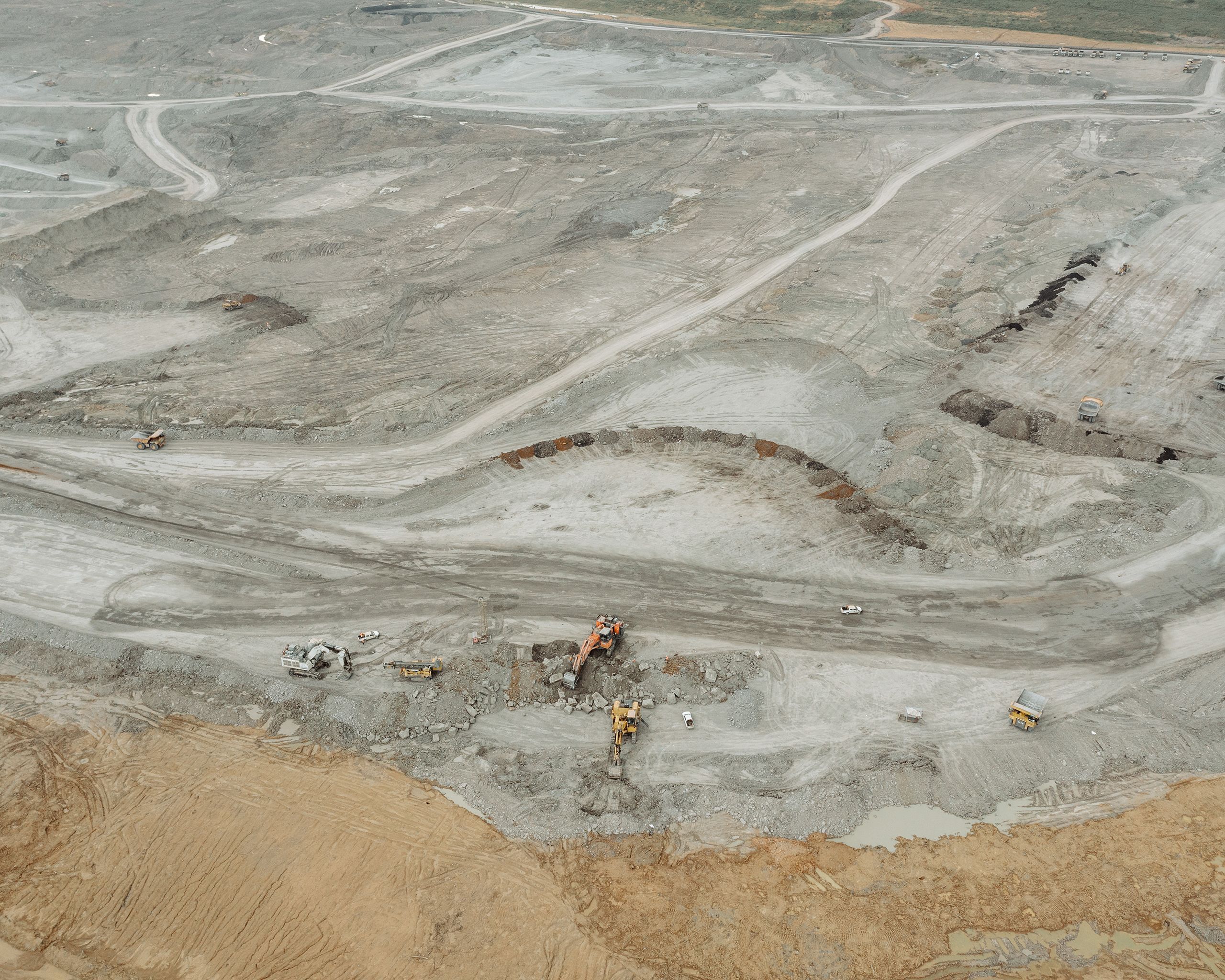
Supported by the liberalisation of foreign investment, and then by the decentralisation of mining processes which gave regional authorities the power to award concessions, the number of operating permits skyrocketed in the 2000s. A decade later, Indonesia has become the world’s top exporter of this sedimentary rock – ahead of Australia. There are now 998 operating permits in force for coal alone. They cover over nine million hectares, primarily in Kalimantan and Sumatra. This is despite recent efforts by the central government to rationalise this, which saw hundreds of non-operational or non-viable licences revoked.
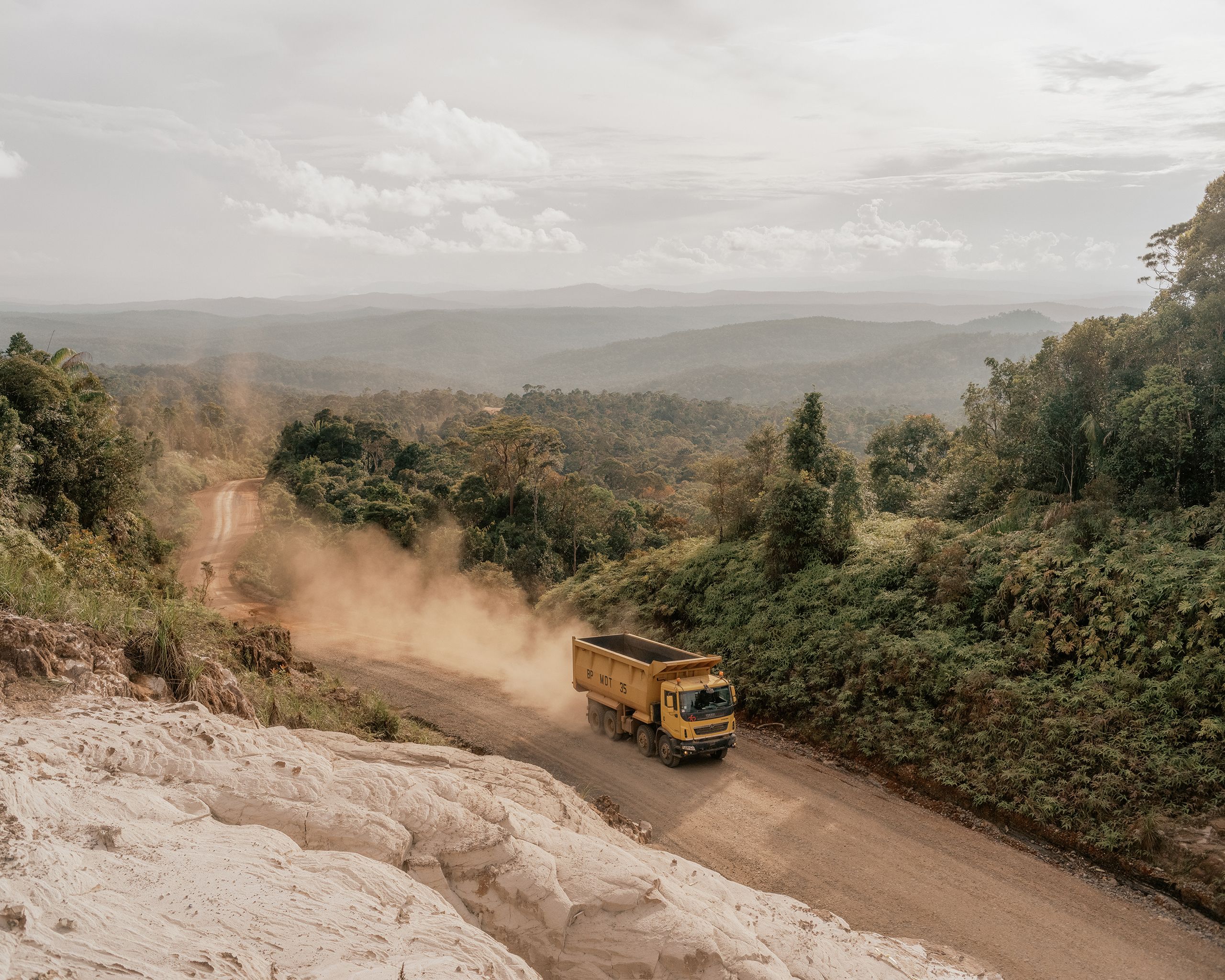
The road from the coal mine to the port terminal also provides access to Tumbang Olong. During the 140 km journey, dust, coal and crashed vehicles are guaranteed.
The road from the coal mine to the port terminal also provides access to Tumbang Olong. During the 140 km journey, dust, coal and crashed vehicles are guaranteed.
The Minister of Energy and Mineral Resources anticipates that in 2023, production will stand at 695 million tonnes of coal, three-quarters of which will be destined for regional powers like China, India or South Korea.
Thanks to its kilometres of coastline and long rivers, Indonesia has not had to invest in expensive infrastructure such as modern railways to export its coal. Its industry relies heavily on a network of small mines focused around the closest river or maritime routes.
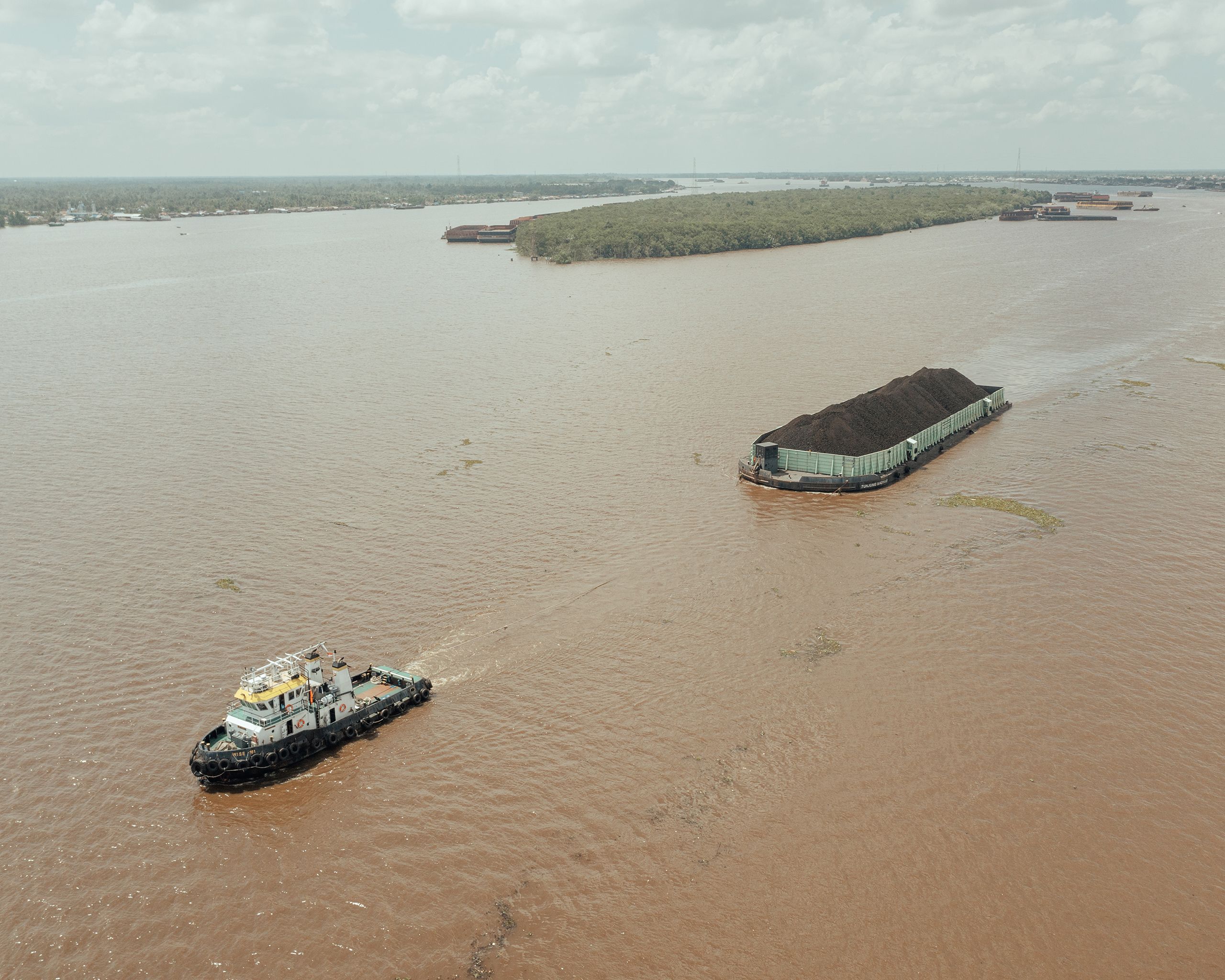
In a fragmented territory, most Indonesian mines are located near a watercourse. The coal is transported on this kind of barge before it reaches thermal power plants or steel factories.
In a fragmented territory, most Indonesian mines are located near a watercourse. The coal is transported on this kind of barge before it reaches thermal power plants or steel factories.
The system has also “enabled the regional authorities to get rich on the way” as licenses are awarded, as Ki Bagus Hadikusumo, of the NGO Jatam, comments bitterly. Up to the highest level, the political elites have invested heavily in the mining sector. Two sons of President Joko Widodo (nicknamed ‘Jokowi’) were members of the board of a mining company active in the coal sector, and many ministers are direct owners. The legislative is also directly concerned. According to a report by Jatam, 55% of the members of parliament are entrepreneurs, half of them in the mining sector. Transparency International ranks Indonesia 110 out of 180 on its Corruption Perceptions Index. Nearly a third of the population reports having been forced to pay a bribe to a civil servant over the course of the past 12 months.
The course of development
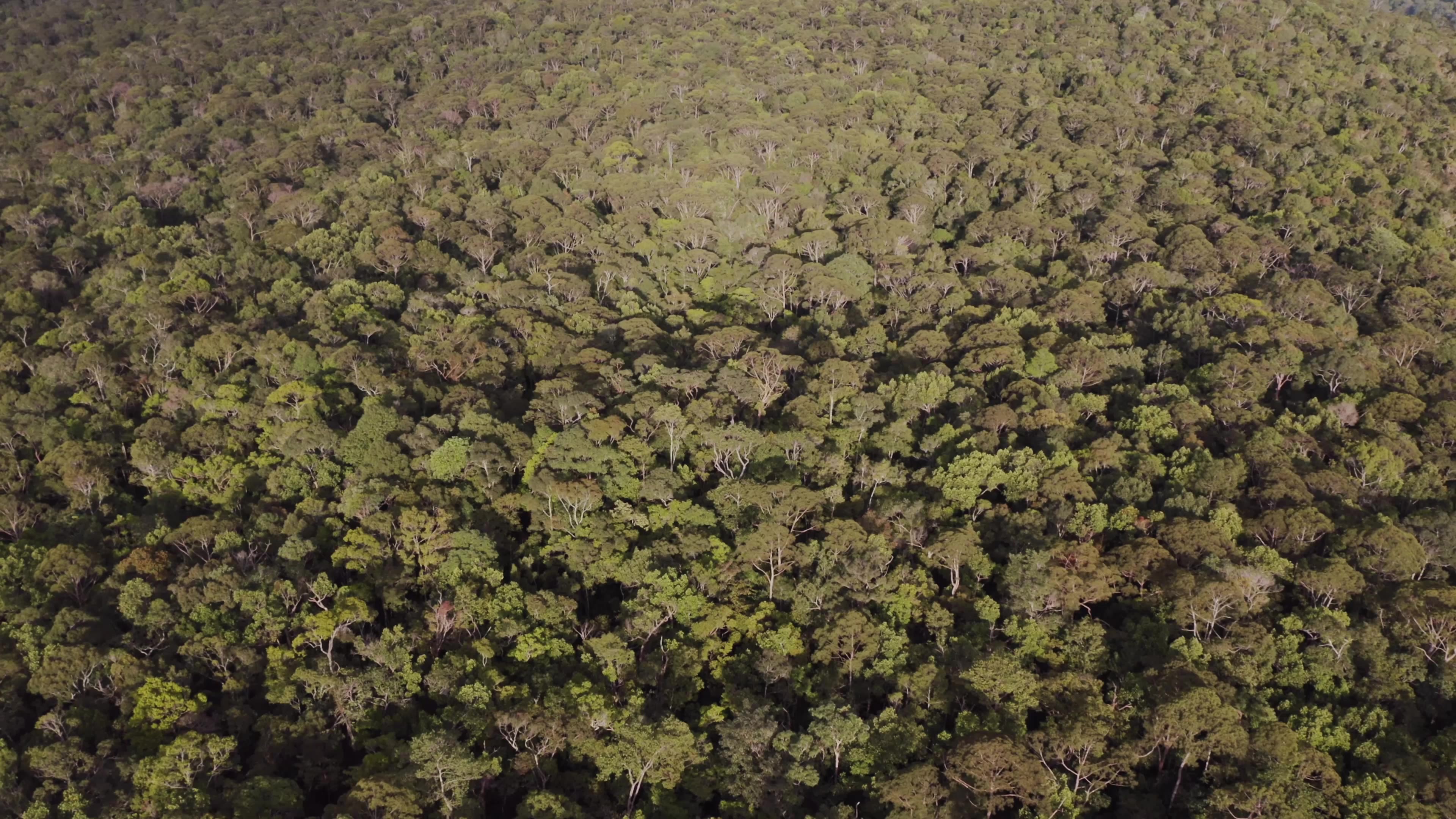
Tarigan comes from a dynasty of politicians and has led the village of Tumbang Olong I for 17 years. The road that crosses the village was built by a logging company when he was a child. He is now in his forties and will finish his third and final mandate in 2025. He recognises the challenges of his role as mediator between the community and the mine. Tarigan stresses the need to pursue economic development to “strengthen the community”, but also voices his reservations in relation to living “side by side” with a “company that shuns all social and environmental responsibility”.
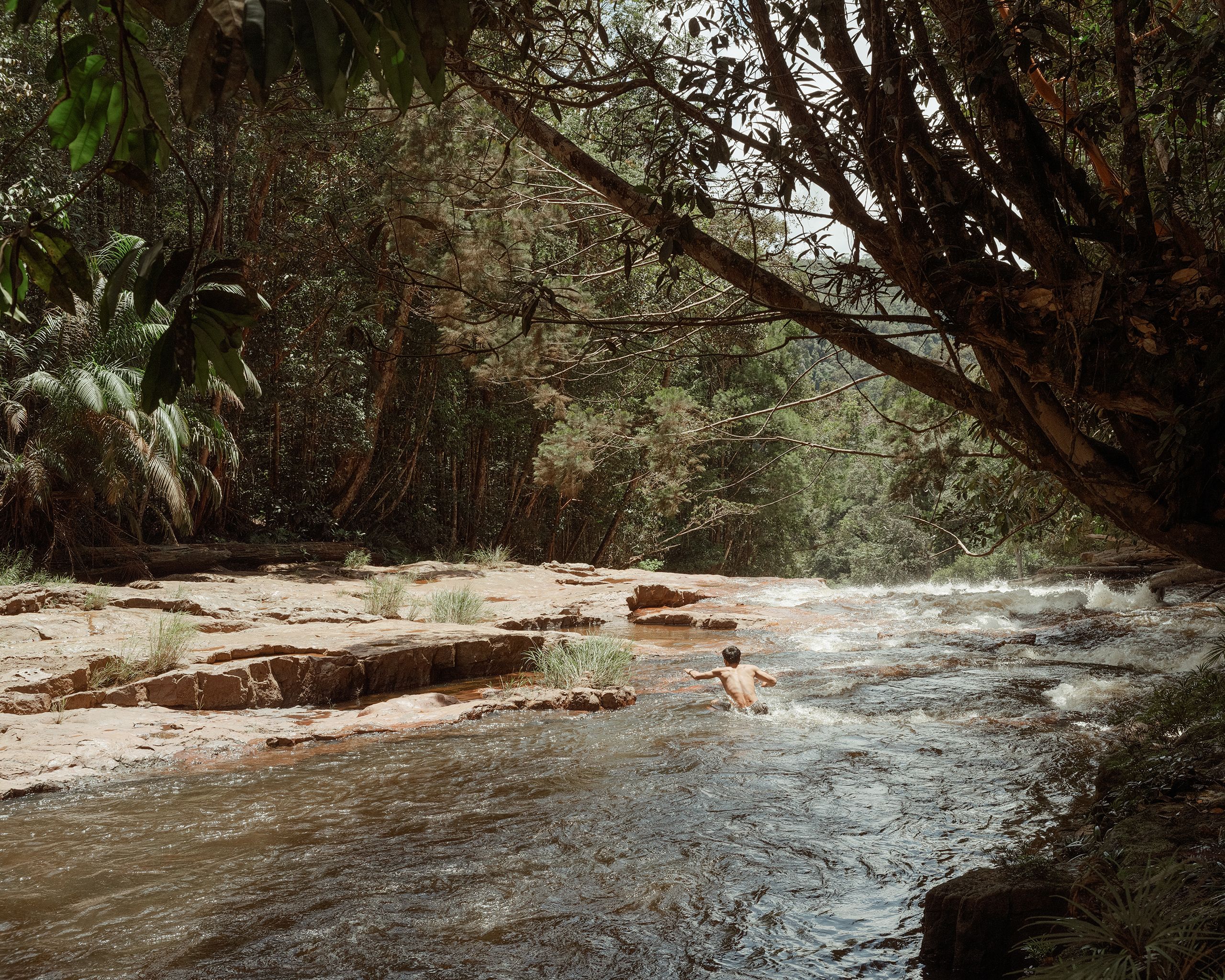
Without access to running water, rivers provide all the daily needs. Contamination of water by mining represents a major risk.
Without access to running water, rivers provide all the daily needs. Contamination of water by mining represents a major risk.
All of Indonesia, the fourth most populous country in the world, faces the same dilemma. President Jokowi is careful not to criticise the mining industry and its derivatives. Elected in 2013 on a promise of maintaining economic growth at 7%, he is simply increasing the country’s dependence on the Coal King both in terms of the level of exports and of the domestic electricity supply provided by the sedimentary rock. Coal now provides for 60% of the energy mix and this is set to increase, driven by the opening of mines and the construction of thermal power stations in the framework of a broad governmental programme launched in 2015. Its code name is: “35 GW”, after the additional capacity on the electricity grid – of which 20 GW is linked to coal.
In a reflection of how the subject makes people uneasy, Indonesian officials agreed to meet us, but only on the condition that they remain anonymous. “Coal is a necessary evil to sustain our development. It is a transitory energy”. This is the official line. Just like India, the country has given itself until 2060 to reach Net Zero, i.e. to become carbon neutral, and until 2037 to leave the most polluting fossil fuels, while continuing to multiply investments in the associated infrastructure.
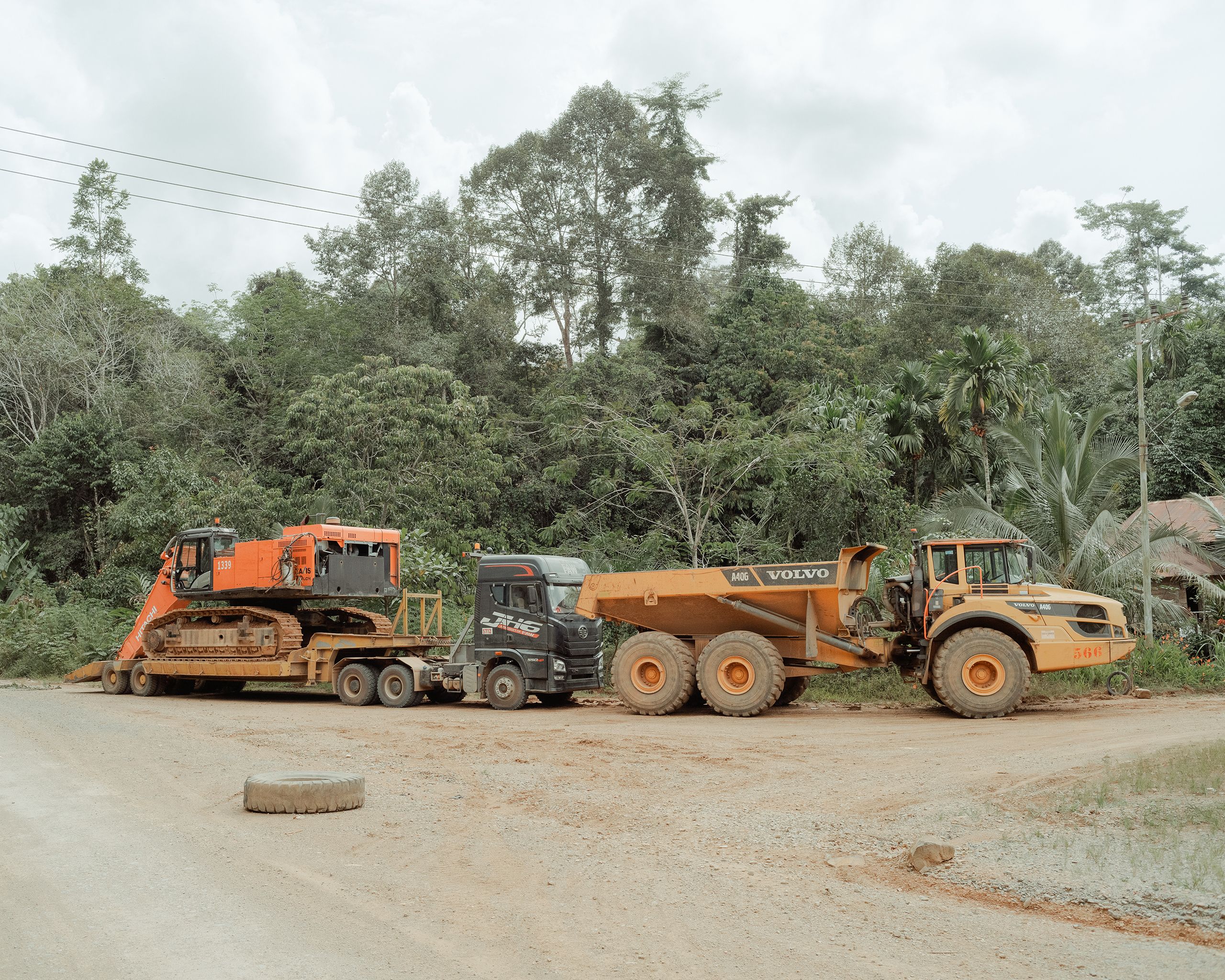
Along the roads, Borneo Prima's heavy machinery is ubiquitous.
Along the roads, Borneo Prima's heavy machinery is ubiquitous.
“Indonesia has no credible plan to get out of coal,” criticises Isabelle Suarez, former collaborator of the environmental research agency CREA. The analyst, an expert from south-east Asia, also points to the role of China and its USD 5.5 billion investment in new coal-fired power plants within the framework of the One Belt One Road initiative, which was launched in 2013 to develop infrastructure in Asia and Africa in particular. For her, Beijing is gradually exporting its coal industry:
“despite its promise to stop funding coal-fired power plants abroad, China has become one of the main funders of captive power stations (power stations that provide energy to industrial or commercial entities) in Indonesia.”
Just as concerning from a climate perspective is the issue of nickel. This metal is essential to the production of electric batteries and is present in large quantities in Indonesia. Although nickel enables the country to present itself as strategic to the energy transition, its extraction has hugely increased the carbon footprint of the country. “Industrial processes rely entirely on coal-fired smelters. The Indonesian paradox is that by increasing electric batteries, we are stimulating coal production,” argues Imam of the NGO Jatam.
Abandoned coal pits
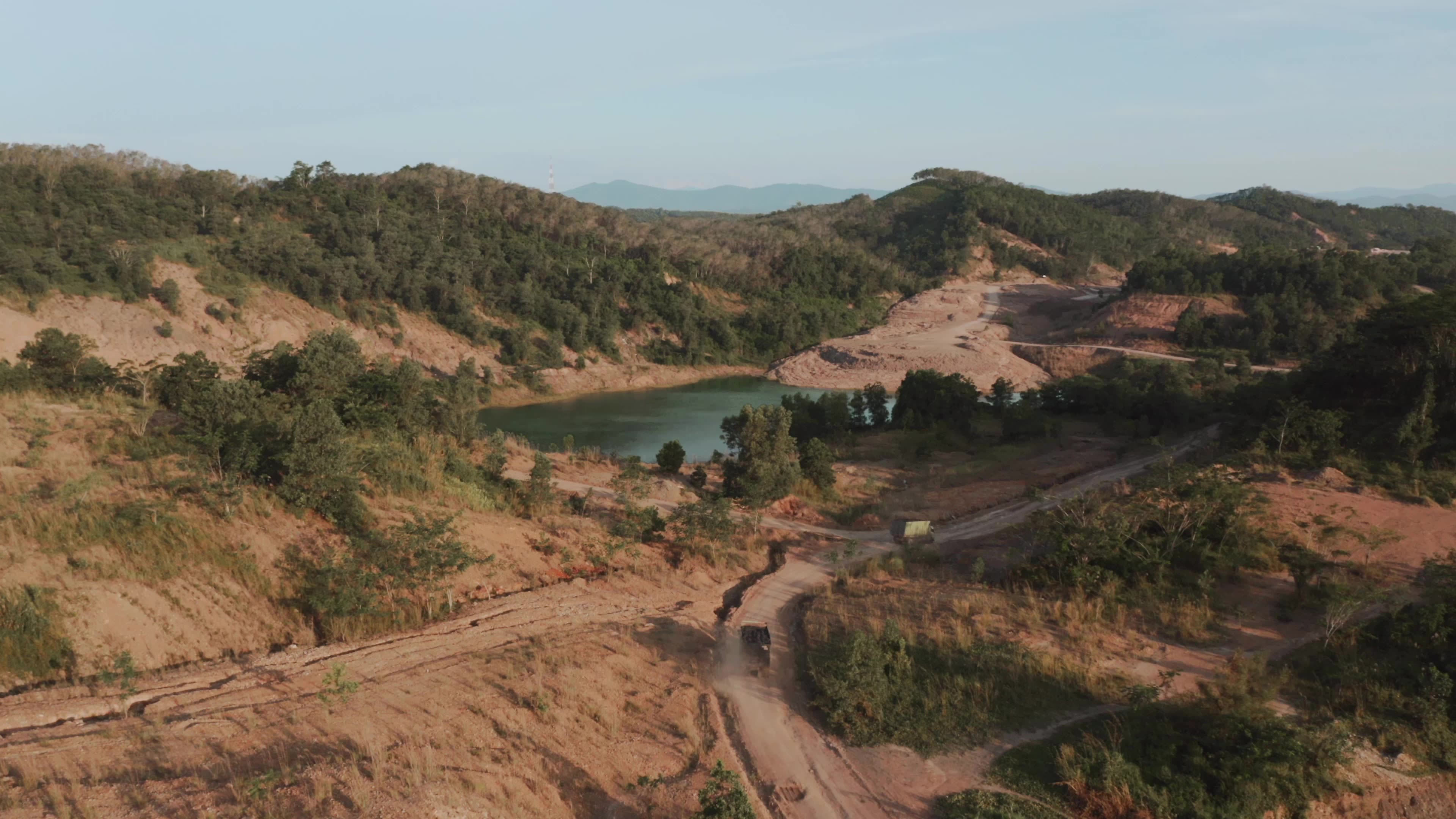
No other province has such close experience of this extractivist model than East Kalimantan, home to 319 coal mines. The local authorities there awarded more mining licenses than in any other province. During periods when prices dropped, such as between 2015 and 2020, miners simply left, without covering over the area they had mined or fencing off the perimeter. In steep terrain, abandoned mines form huge lakes brimming with rainwater. According to a 2019 study by Jatam, 80 wells have been abandoned around the city of Samarinda, where 80% of land is covered by concessions. However, thanks to his film Sexy Killers, viewed 37 million times, grieving families are becoming aware that they are not the last victims of the coal industry.
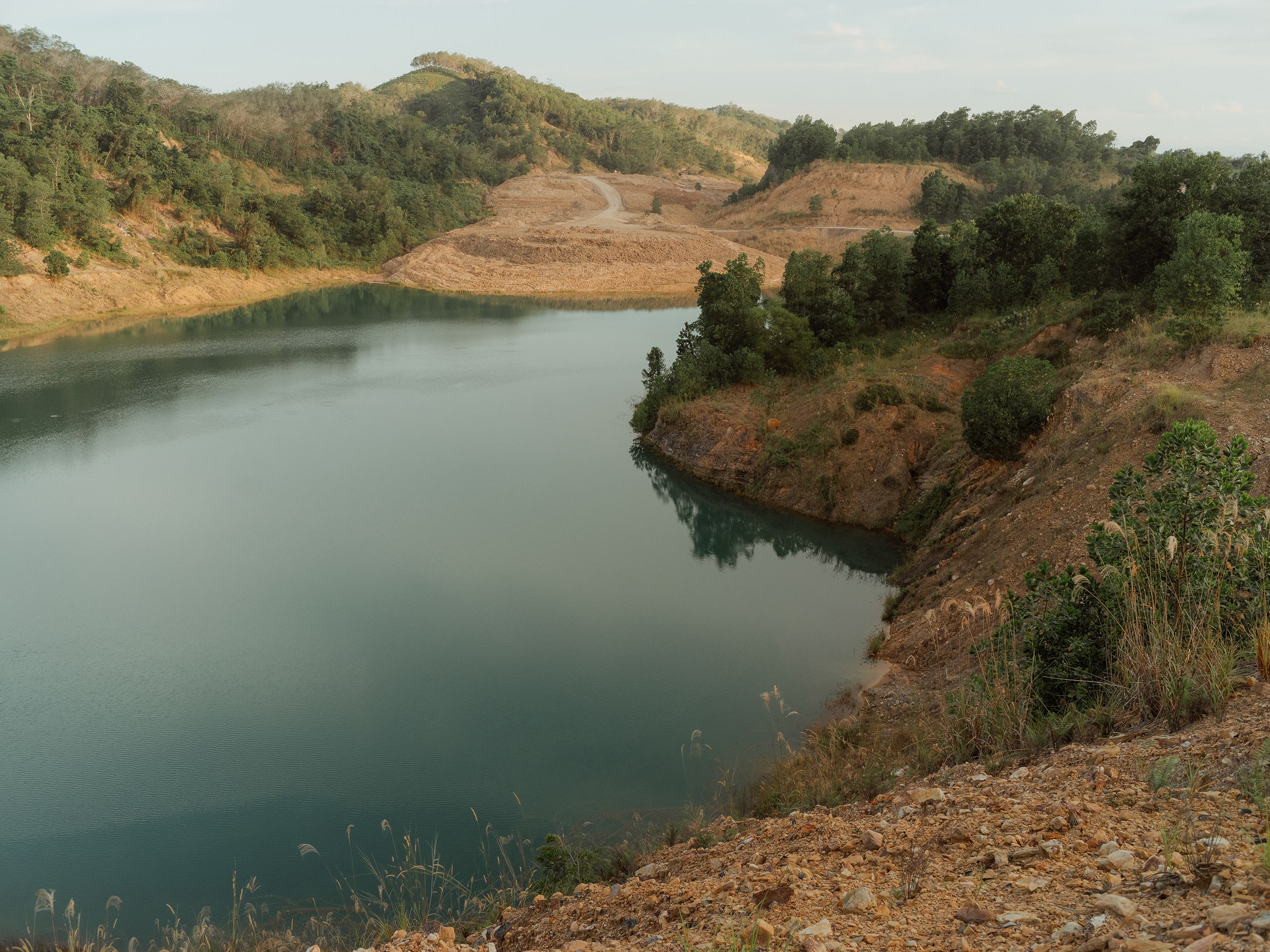
When the price of coal falls, some of the mines are simply left behind. The beauty of the rainwater-filled wells, which have turned into lakes, is only matched by their dangerousness.
When the price of coal falls, some of the mines are simply left behind. The beauty of the rainwater-filled wells, which have turned into lakes, is only matched by their dangerousness.
Sanctions imposed on Russian coal and the subsequent increase in prices also had an unexpected impact on the region, for example around this blue lake in East Kalimantan, a mine abandoned in 2013 by the company Carakamulia. Its waters have since been favoured by local tourists taking selfies, but the comments left on Google Maps warn people “don’t dive in the water”. Public Eye was able to establish that mining companies have returned to the region. Only a few trees had been planted as ‘rehabilitation’ and yet trucks have once again started circulating around the blue lake.
The “other” Swiss mine, between transition and business
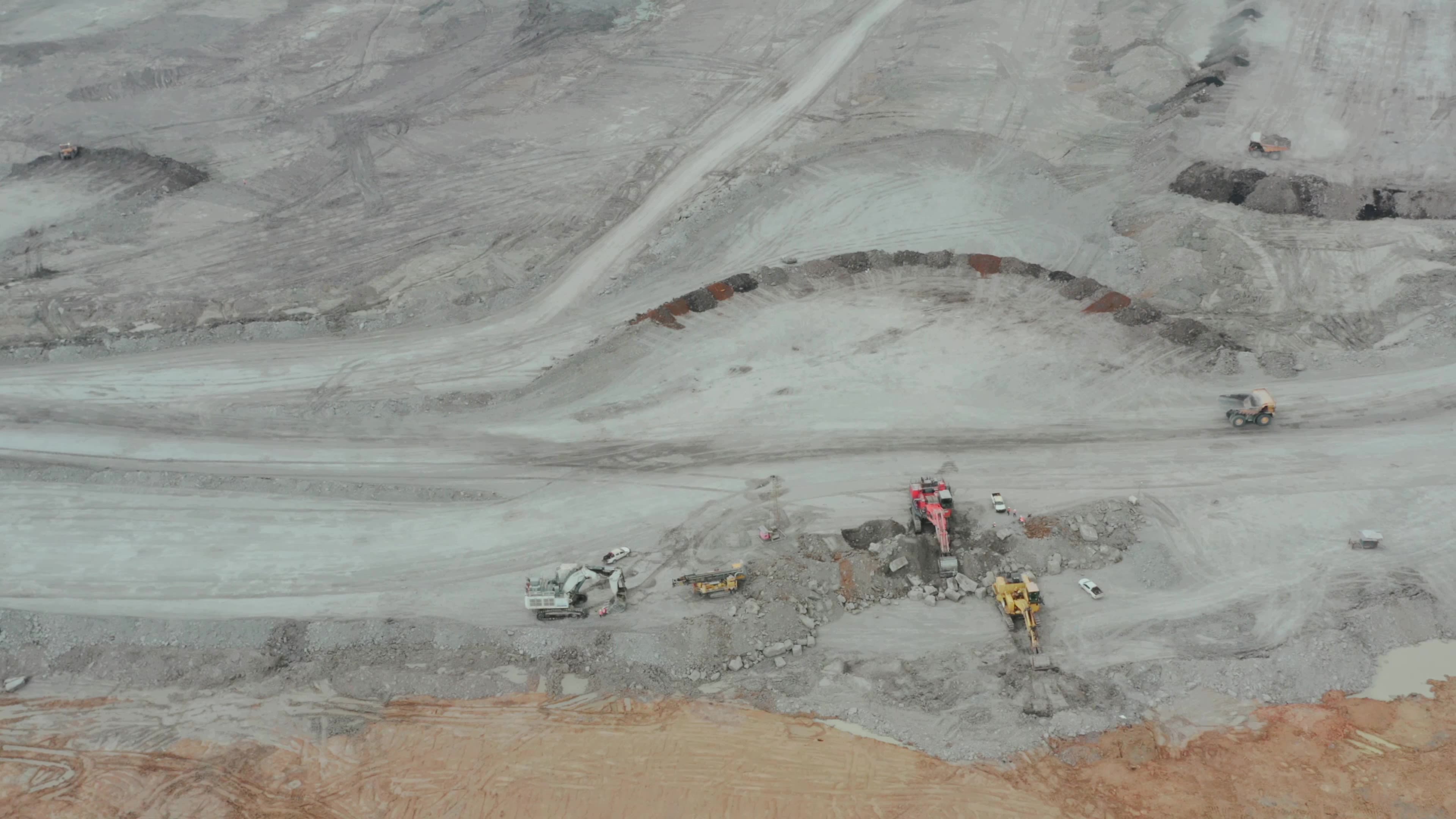
Mercuria stood fast alongside Indonesian coal at the end of the commodity price super cycle in 2015. “When prices were low, local miners shut down. But Mercuria always kept operating”, confirms a vendor of satay skewers who seems to be well-informed about the comings and goings of the miners in this region of South Kalimantan.
It is indeed in this province where we encounter one of two coal mines run by Mercuria (the other one being in South Africa), the most authentically ‘Geneva’ of the large commodity multinationals. In front of the gate of its subsidiary Kalimantan Energi Lestari (PT KEL), operating day and night since 2012, an employee was surprised to see a Swiss-Indonesian delegation come to engage in some tourism in front of a Geneva-based mine, in a region that doesn’t exactly feature in tourist guidebooks.
Nonetheless, the site – where roads are partially eroded, mountains are made of limestone and subterranean mines are operated by Chinese companies – is worth the detour. On the south-eastern side, a long row of oil palm trees masks Mercuria’s 6,000-hectare concession (1,000 hectares of which is currently being exploited). Annual production stands at 1.5 million tonnes of coal, washed then dispatched “as far as Poland” according to a proud employee. It has to be said that the war in Ukraine and the subsequent sanctions on Russian coal caused prices to skyrocket, making coal more profitable than ever and opening up new commercial routes.
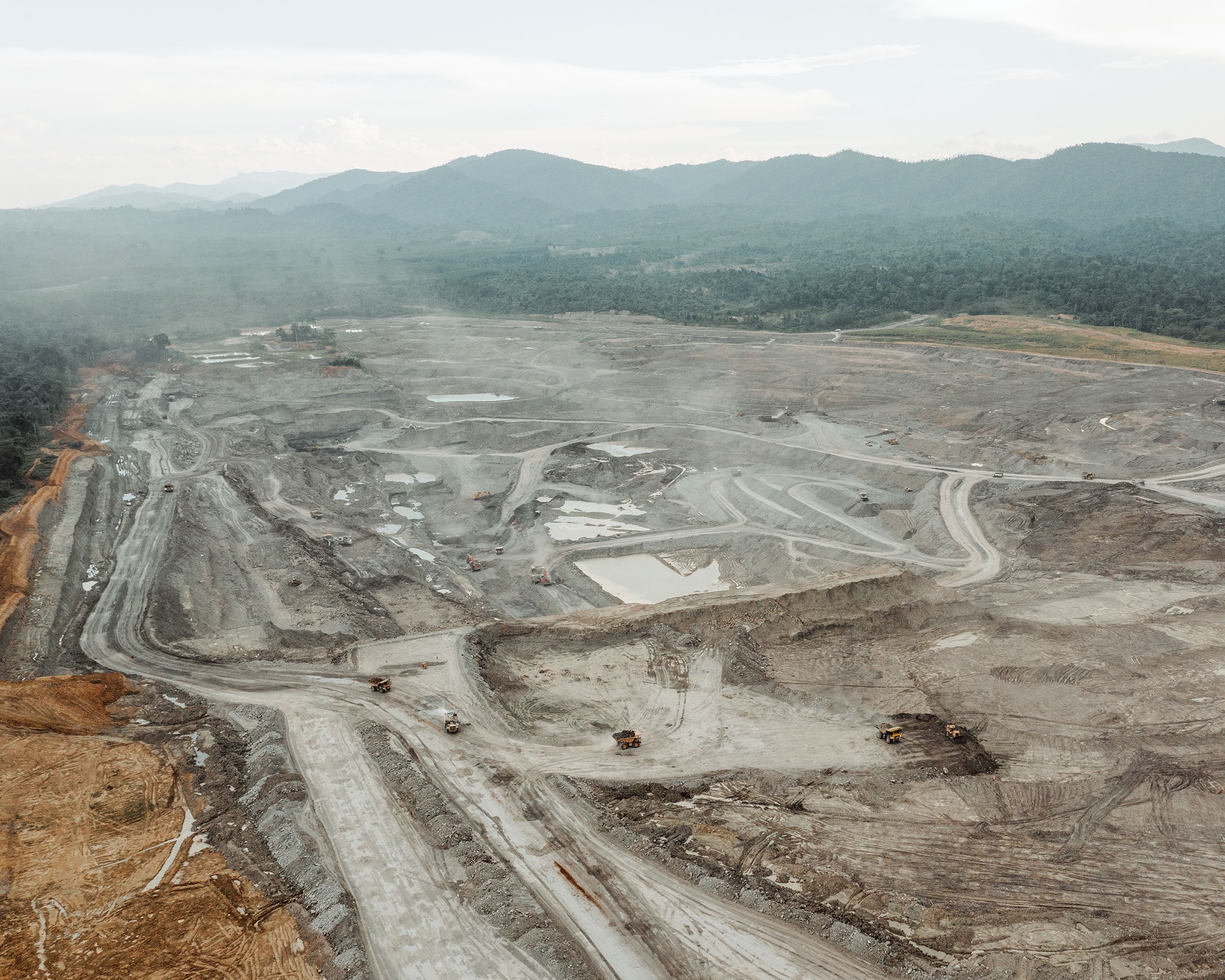
Mercuria has bought the South Kalimantan coal mine. After a decade of exploitation, the company from Geneva ensures that it is now at the end of its life. On site, it does not look as certain.
Mercuria has bought the South Kalimantan coal mine. After a decade of exploitation, the company from Geneva ensures that it is now at the end of its life. On site, it does not look as certain.
Mercuria is always modest about its involvement in coal in front of the media and at large events. In March 2023, at Lausanne’s FT Global Commodities Summit, CEO Marco Dunand chose to downplay the weight of coal in the group’s results. Indeed, Mercuria is better known as a commodities trader than as a mining company. “3% of revenues is not nothing” pointed out on stage a journalist from the Financial Times, which organised the summit. At the request of Public Eye, the company confirmed that it makes USD 3.48 billion (of total revenues of USD 174 billion) from the production of and trade in coal in 2022. Mercuria sold some 17 million tonnes.
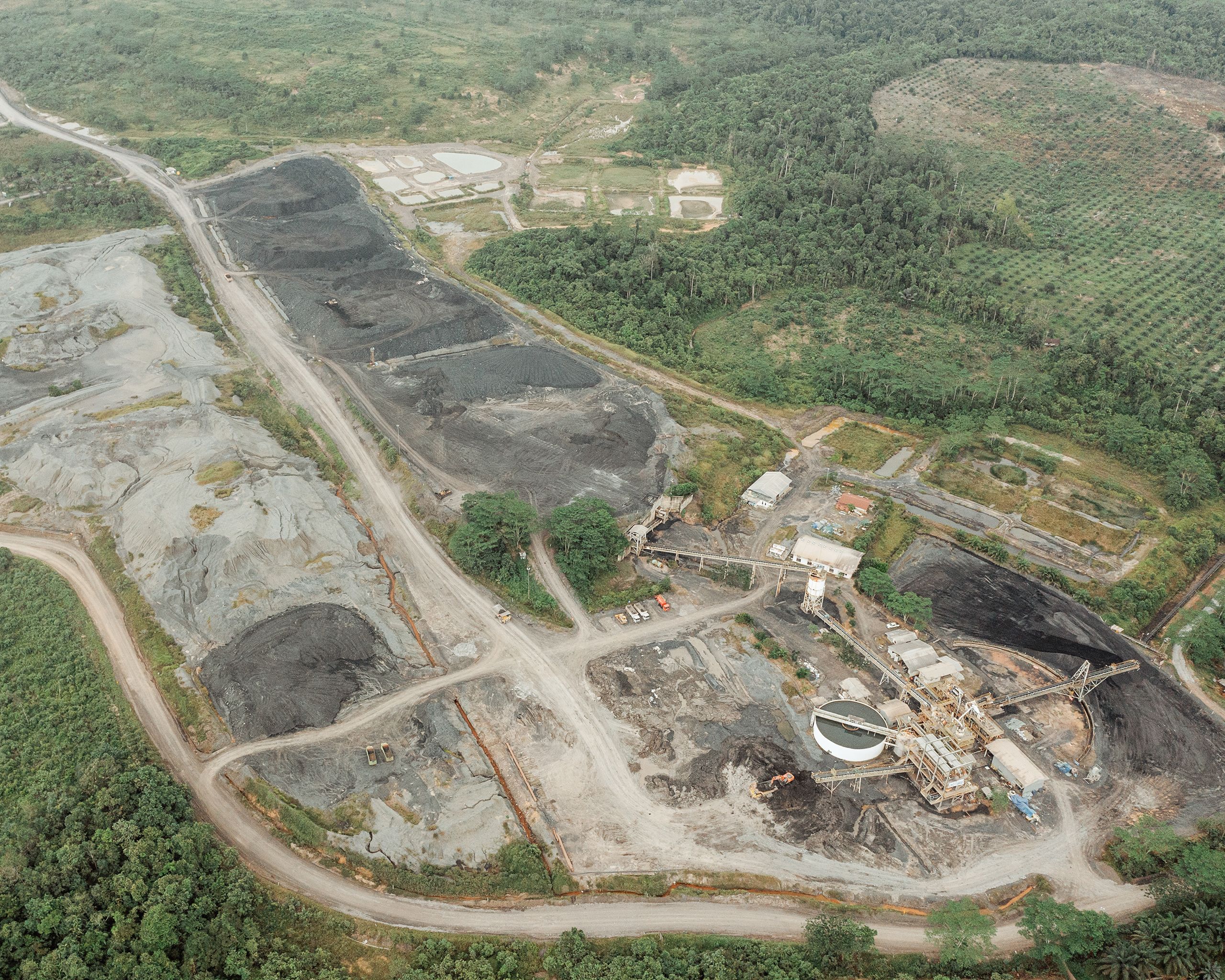
KEL, Mercuria's coal mine, is lined with oil palm trees. Along with coal and the timber industry, palm oil is one of the greatest threats to Borneo's rainforest.
KEL, Mercuria's coal mine, is lined with oil palm trees. Along with coal and the timber industry, palm oil is one of the greatest threats to Borneo's rainforest.
The Geneva-based giant did not however wish to open its door to Public Eye. Nor did it wish to authorise an interview with one of its local representatives. Mercuria states that it is “engaged in decarbonising the economy” through its investments in renewable energy. A company representative considers that in this sense, “it is not necessary to further highlight Mercuria’s already limited exposure to this type of product [N.D.L.R, coal].”
In writing, the multinational nonetheless recalls that the sedimentary rock still represents over a third of primary energy produced in the world: “removing coal from the energy mix should be planned in an orderly manner to ensure a well-balance supply and demand during the full transition period”.
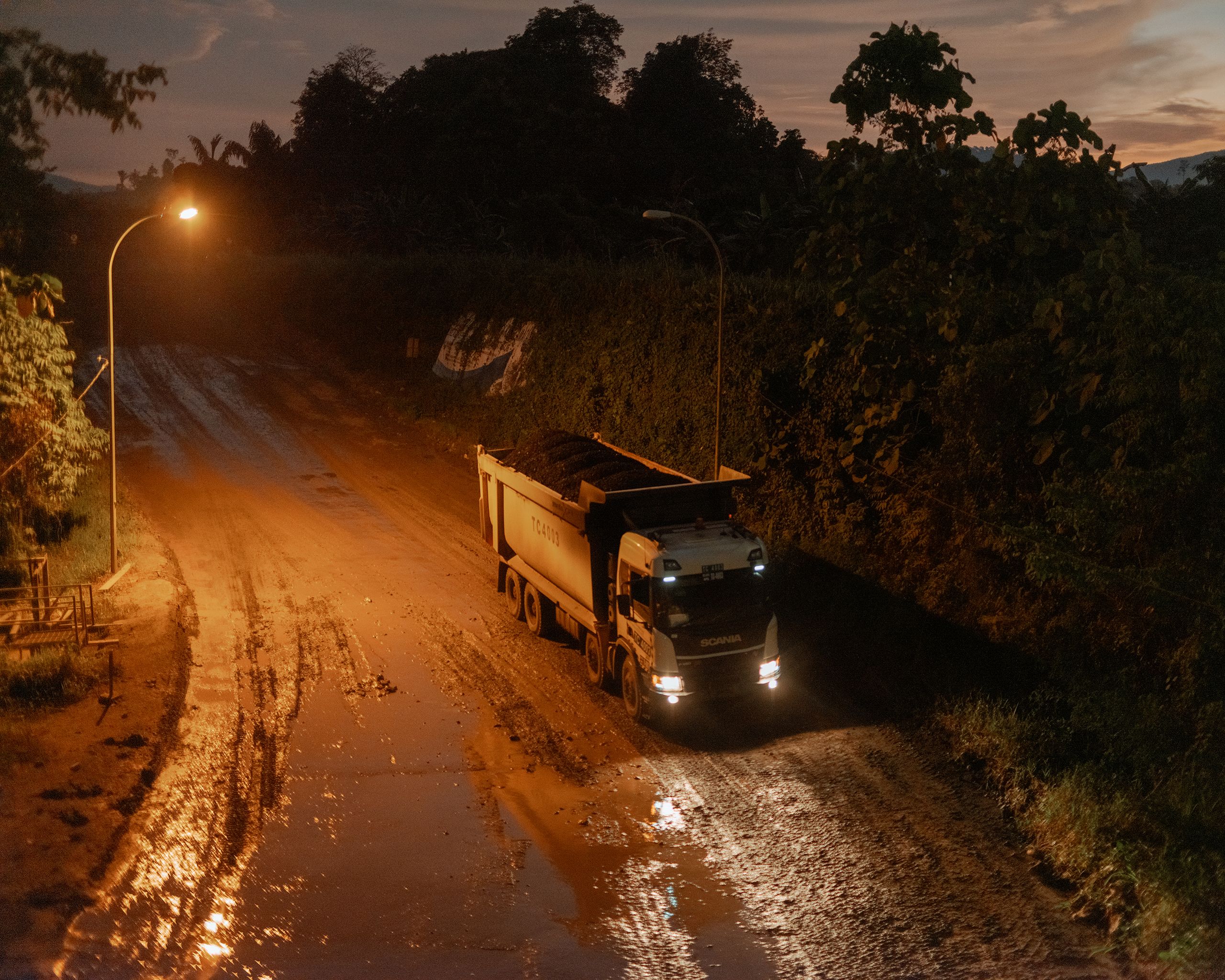
Mercuria has its own fleet of trucks to transport its coal miners 24 hours a day.
Mercuria has its own fleet of trucks to transport its coal miners 24 hours a day.
At KEL, Mercuria is promising that “operations will gradually decrease” after ten years of operations, but it also refers to the “potential for additional resources” that “are still due to be subject to economic feasibility studies”.
No one in the region has heard talk of an exit plan or forthcoming closure of the mine, something nobody will complain about. The company currently employs some 180 people and will not grow its workforce, assures Mercuria. “Retraining staff at site is a priority. The end of mining operations should be planned in such a way as to ensure the smoothest possible transition to alternative livelihoods” insists the company representative. Salaries are comparatively high by regional standards. “A truck driver can earn up to 12 million rupees a month (CHF 730)” a restaurant owner confirms. This is three times the minimum wage.
There is greater uncertainty around the future of KEL at the headquarters in Geneva than at site. On Mercuria’s website, the page referring to its coal mines disappeared after our exchange. But the local community should be reassured – KEL is still publishing job offers.
Tali asih, mining charity
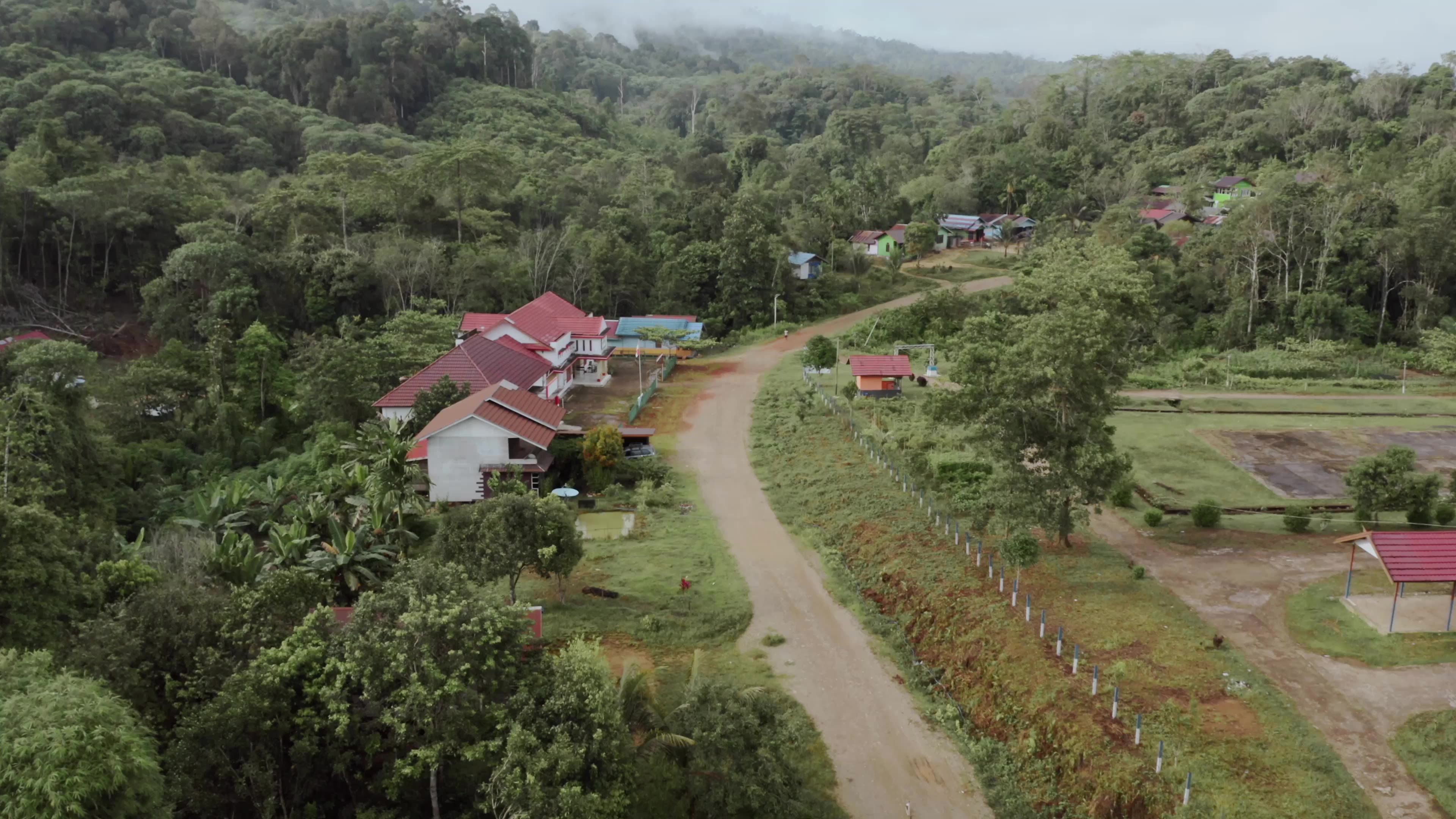
A brown folder is nervously fiddled with. On the front of the pocket, Dewi Sertika has conscientiously made an annotation in Bahasa – “Statement of work with PT BP (Borneo Prima)”. During the course of her account, the woman in her early forties pulled documents and certificates illustrating her points from the bag – as if her own existence and the fate of her four children were all contained in the folder.
The first document is a letter recognising ownership of a plot of land comprising three hectares. Now located on the concession exploited by the mine, it has already enabled BP to “extract tonnes of coal”, according to Dewi Sertika. After moving heaven and earth at the town hall, she finally obtained the precious letter. “But they say it has no legal value” she says. Her sister also saw her house destroyed by BP’s bulldozers.
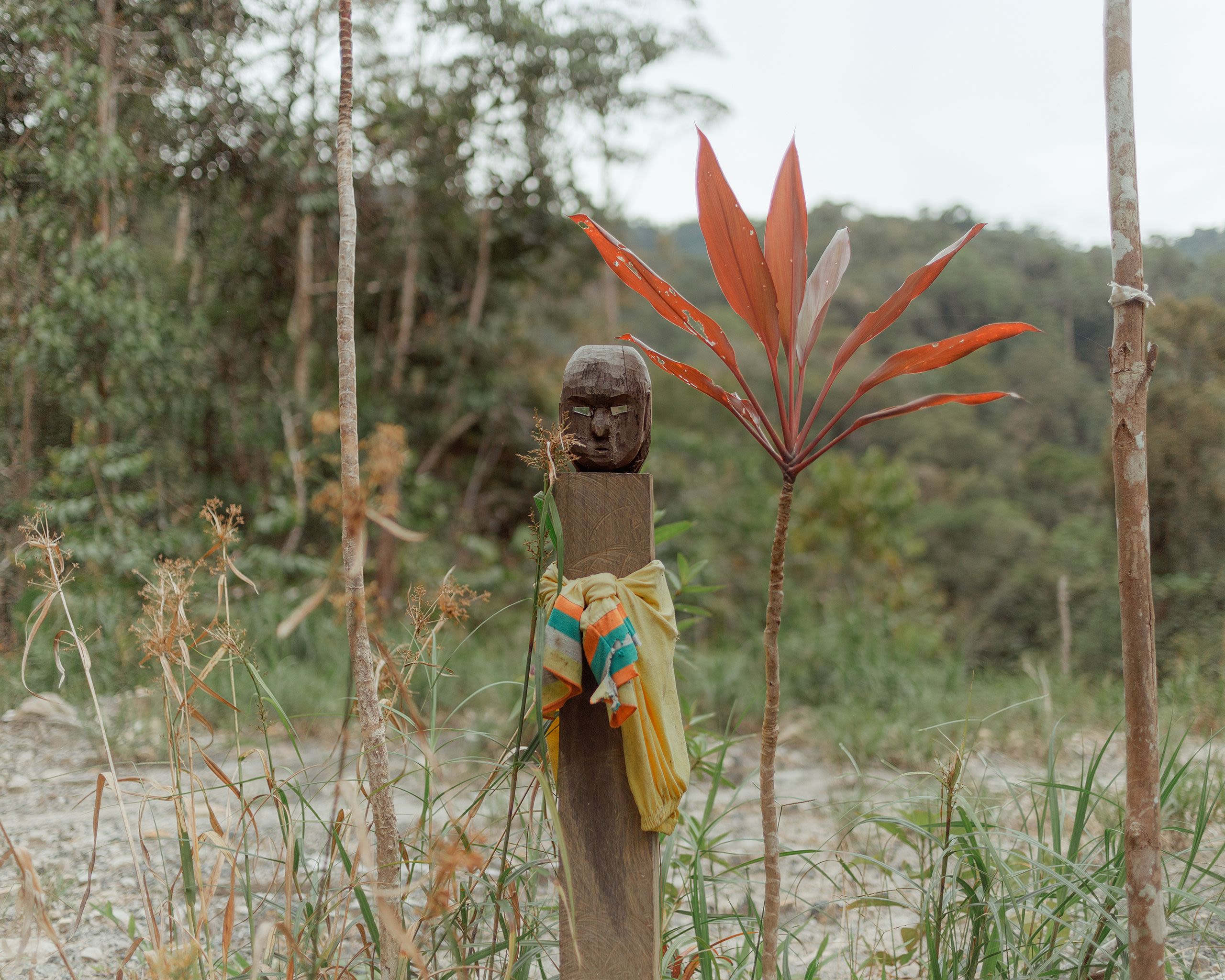
The tokahan of Dewi Sertika's aunt is located within the perimeter of the mine. Dayak people believe that the soul of the deceased rest in these sculpted poles.
The tokahan of Dewi Sertika's aunt is located within the perimeter of the mine. Dayak people believe that the soul of the deceased rest in these sculpted poles.
The second document is an agreement reached with BP to push her to move her aunt’s tokohan. Her relative died last year within the perimeter of the mine. In the Dayak tradition, the statue represents the soul of the deceased, and BP’s contractors didn’t dare touch it for fear of getting the evil eye.
The third and last document is a contract with no name. It is dated 20 January 2023 and the words ‘Tali asih’ are written in bold on it. This means – in the Indonesian understanding of it – a form of charity. Indeed, when reading carefully, BP resolves Dewi Sertika’s problem by exchanging her three hectares for a small ‘donation’, put at 10 million rupees per unit (CHF 607). She nonetheless assures us that “I wasn’t aware I was selling my property when I signed this document”. The rest of the text stipulates that Dewi Sertika and her heirs commit to refrain from suing the mining company. “This is a copy, BP kept the original” she explains, while her children discreetly observe the visitors from behind the curtains.
More “disappointed than angry”, Dewi Sertiak is grateful for the money that has been disbursed by the mining company. She nonetheless admits that she doesn’t understand the attitude of the local authorities, who seem to be more worried about promoting the interests of the mining investors than about protecting the community.
Before slipping away to collect water from the river, she adds: “The village chief of Tumban Olong II even told me that we should be ashamed of ourselves for protesting, because we use BP’s road”. The course of development is decidedly unstoppable.
*first name amended
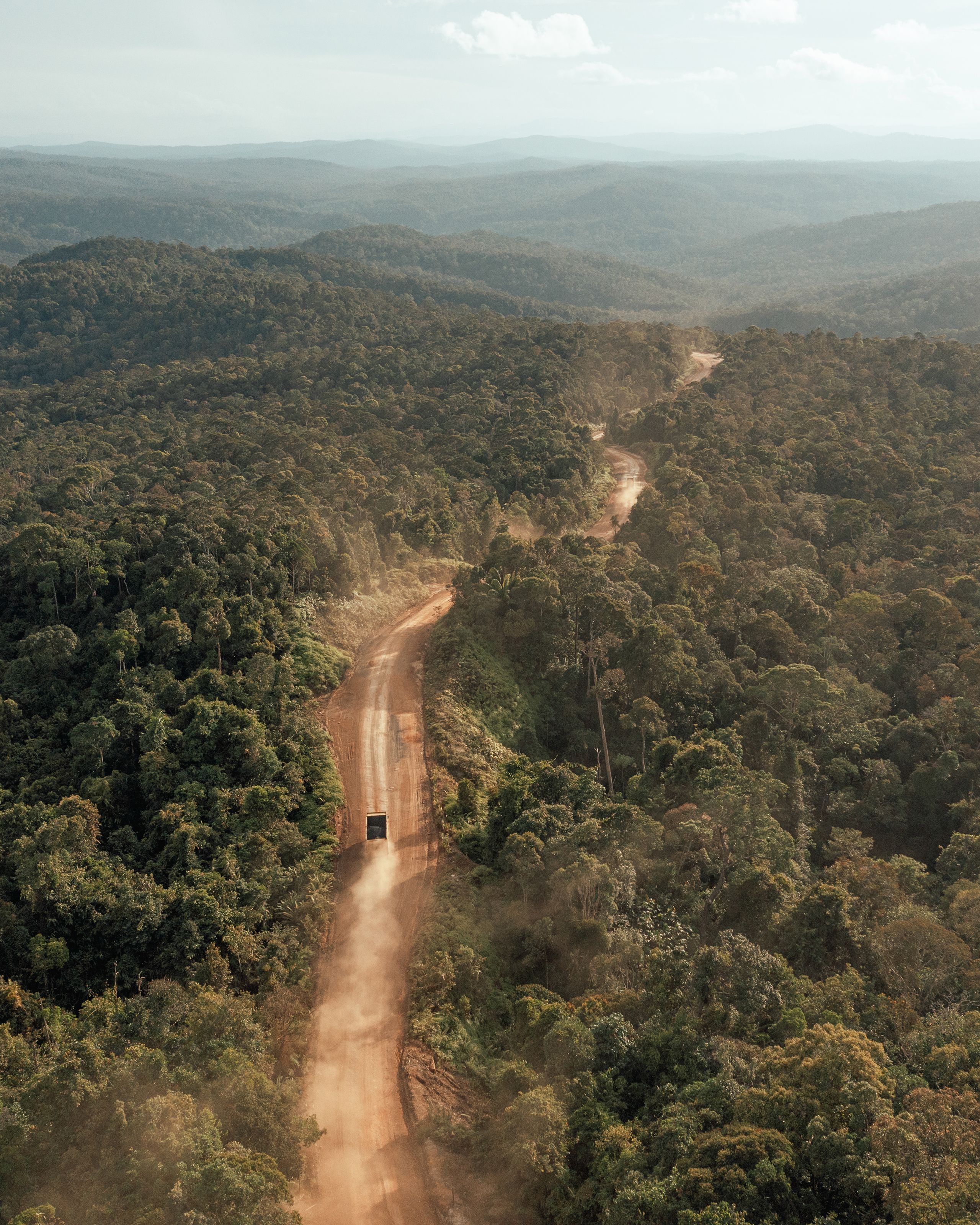
In the distance, the dust clouds raised by the coal trucks from Borneo Prima can be seen.
In the distance, the dust clouds raised by the coal trucks from Borneo Prima can be seen.
Our exclusive research in video
With Public Eye in the heart of Borneo
Swiss NGO Public Eye offers a critical analysis of the impact that Switzerland, and its companies, has on economically disadvantaged countries. Through research, advocacy and campaigning, Public Eye also demands the respect of human rights and of the environment throughout the world. With a strong support of some 28,000 members, Public Eye focuses on global justice.
Reports like this one are only possible thanks to the people who support us: with a donation, you help us remain entirely independent.
Imprint
Investigation: Adrià Budry Carbó, Public Eye
English translation: Kim Park
Pictures and drone videos: Muhammad Fadli / Panos
Illustrations: opak.cc
Web implementation: Fabian Lang

